Microsoft Project is a project management software that’s commonly used by 35,000+ companies around the globe, but that doesn’t mean it’s the best tool. This forces some to seek a Microsoft Project alternative for effective collaboration and lower prices.
As projects grow in complexity and workforces expand globally, the need for online project management tools is no luxury. There is no lack of MS Project alternatives to choose from, with varying degrees of usefulness and project management features. Microsoft has thrown its considerable weight into the ring with Microsoft Project. While MS Project has become an industry standard in project management, it comes with problems, leaving people to search for the best Microsoft Project alternative.
Why People Seek a Microsoft Project Alternative
Microsoft Project can do much of what you need when planning and managing a project, but it’s not a perfect tool. There are many reasons why people who use it are searching for Microsoft Project alternatives. Thankfully, many other project management solutions on the market offer users a great alternative to Microsoft Project. We’ll get to those in a moment, but first, let’s outline the reasons people are dissatisfied with MS Project.
- Steep Learning Curve for Users: Microsoft Project is not for beginners. The software is very technical and not user-friendly. That might be fine if you have an advanced degree in project management, but for the rest of us, it’s going to require a lot of work, time and training to get a handle on how to use the tool. Why do that when you can simply use one of the best MS Project alternatives?
- No Microsoft Project Mobile App on Android or iOS: It’s hard to imagine a project management software in 2025 without a mobile app, but somehow Microsoft Project doesn’t have one. This is going to severely limit your team’s ability to update tasks from the field. This may be reason enough to find an MS Project alternative for some.
- Poor Team Communication, Even on Microsoft 365: Microsoft Project falls short in this category. You can’t easily message your team in the app, which means you’re going to have to jump onto one of the messaging tools that Microsoft offers, such as Teams, Outlook or Skype. Why do you want an add-on when it’s so much more efficient to choose a Microsoft Project alternative?
- Microsoft Project Doesn’t Integrate with External Apps: While MS Project works okay with other Microsoft products, that’s not the case if you want to use a tool outside of the Microsoft family of apps. So, if you’re looking to integrate with Salesforce, Slack or other tools, you’re probably going to find yourself frustrated and looking for MS Project alternatives.
- Microsoft Project Pricing is Confusing and Expensive: If money is your bottom line, then Microsoft Project’s price tag will be a tough pill to swallow. The current editions of Microsoft Project, Project Standard 2024 and Project Professional 2024 are sold as a one-time purchase for $679.99 and $1,129.99 respectively. What makes matters worse is that you have to pay for each license. You may have to selectively license MS Project to your team. Luckily there are low-cost and even free Microsoft Project alternatives in the market.
- It’s Hard to Share Data with Other Project Management Software: It’s almost as if Microsoft Project doesn’t want your team to work together. If anyone on your team works on an Apple product, they’re out of luck. It’s such a problem that a cottage industry of online tools has emerged that offer ways to take MPP files, convert them into friendlier formats to edit and share and then convert them back to MS Project files. That’s not very efficient!
20 Best Microsoft Project Alternatives of 2025
There are many Microsoft Project alternatives in the market, each of which has key features and characteristics that make them unique. The following list includes free, freemium, cloud-based or open-source options. Look through them and decide the best Microsoft Project alternative for you.

1. ProjectManager
ProjectManager is online project and portfolio management software that tops our list for its incredibly rich project data, competitive pricing and compatibility with Mac. This MS Project alternative helps you plan and schedule projects while delivering real-time updates with live dashboards and powerful reporting tools to continuously improve analysis and performance. And there’s a free 30-day trial so you can try it out, risk-free.
Award-winning Gantt Charts for Precise Project Schedules
ProjectManager’s Gantt chart software is unmatched: no other Microsoft Project alternative offers four types of dependencies, baseline tracking, real-time workload data, critical path filtering and more. Of course, not everyone works the same, which is why you get access to five different project views including Gantt, kanban, task list, spreadsheet and calendar. As teams execute tasks, even on the mobile app, data is updated instantly across the software offering reliable dashboards and reporting.
Get All the Robust Features, Plus Mac Compatibility
ProjectManager not only works on all Mac products but it does nearly everything that MS Project does, faster, easier and at a lower price point, which puts it at the top of the best Microsoft Project alternatives list. You can collaborate without jumping through hoops and manage schedules, resources, workload and much more. Plus, ProjectManager has real-time dashboards that compile data instantly, streamlining analysis and reporting tasks.
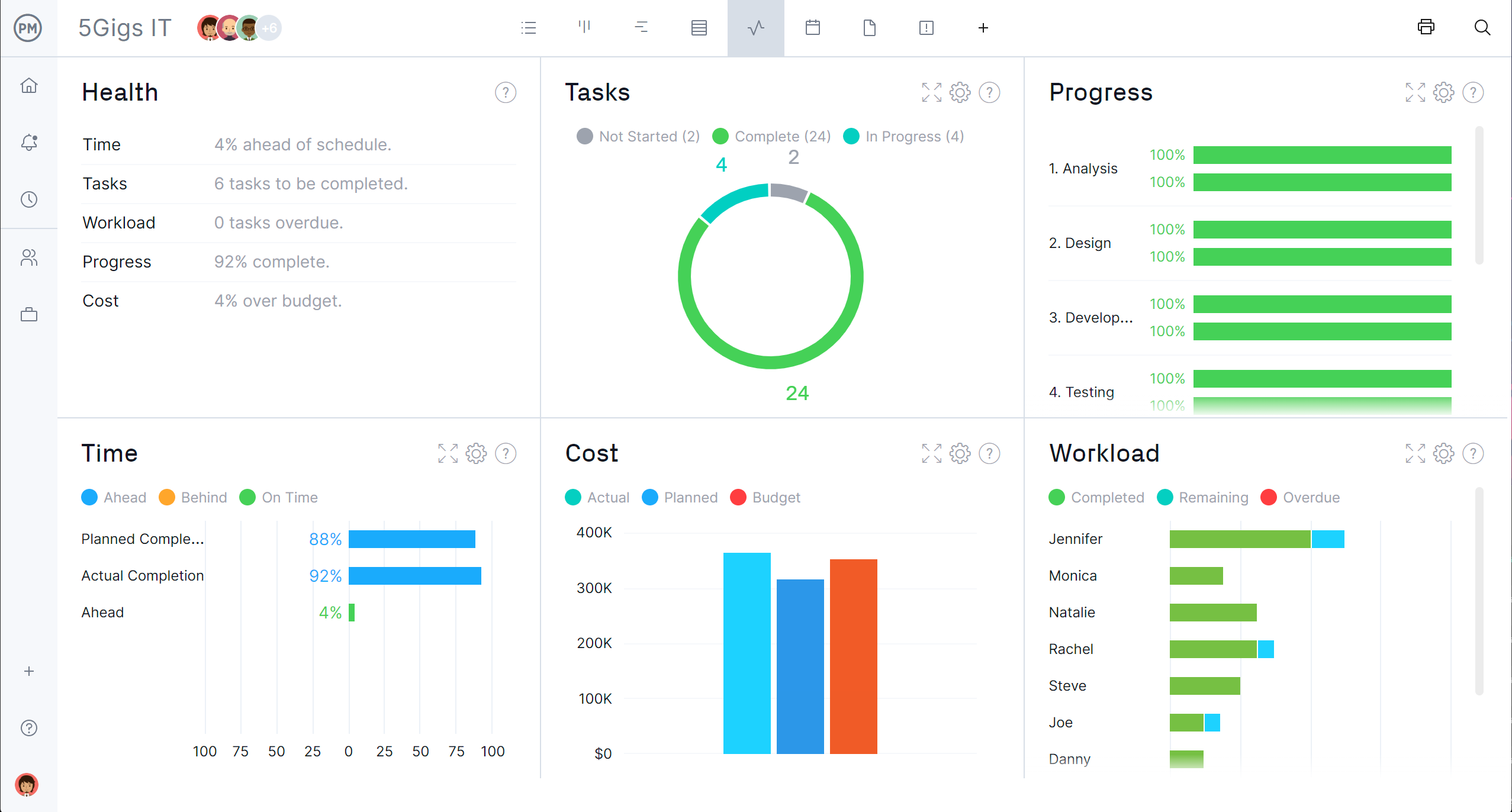
Intuitive Resource Management
In addition to best-in-class project planning features, ProjectManager also offers a painless resource management experience. When scheduling tasks, real-time resource availability appears, so the workload is always balanced. When the project gets underway, you can use the team page to see all the tasks your team is working on in one place. Filter by team type, project and date range to stay on top of your team’s progress. Click on a task to make updates, or reallocate work instantly. You can’t get that level of team management and collaboration in Microsoft Project.
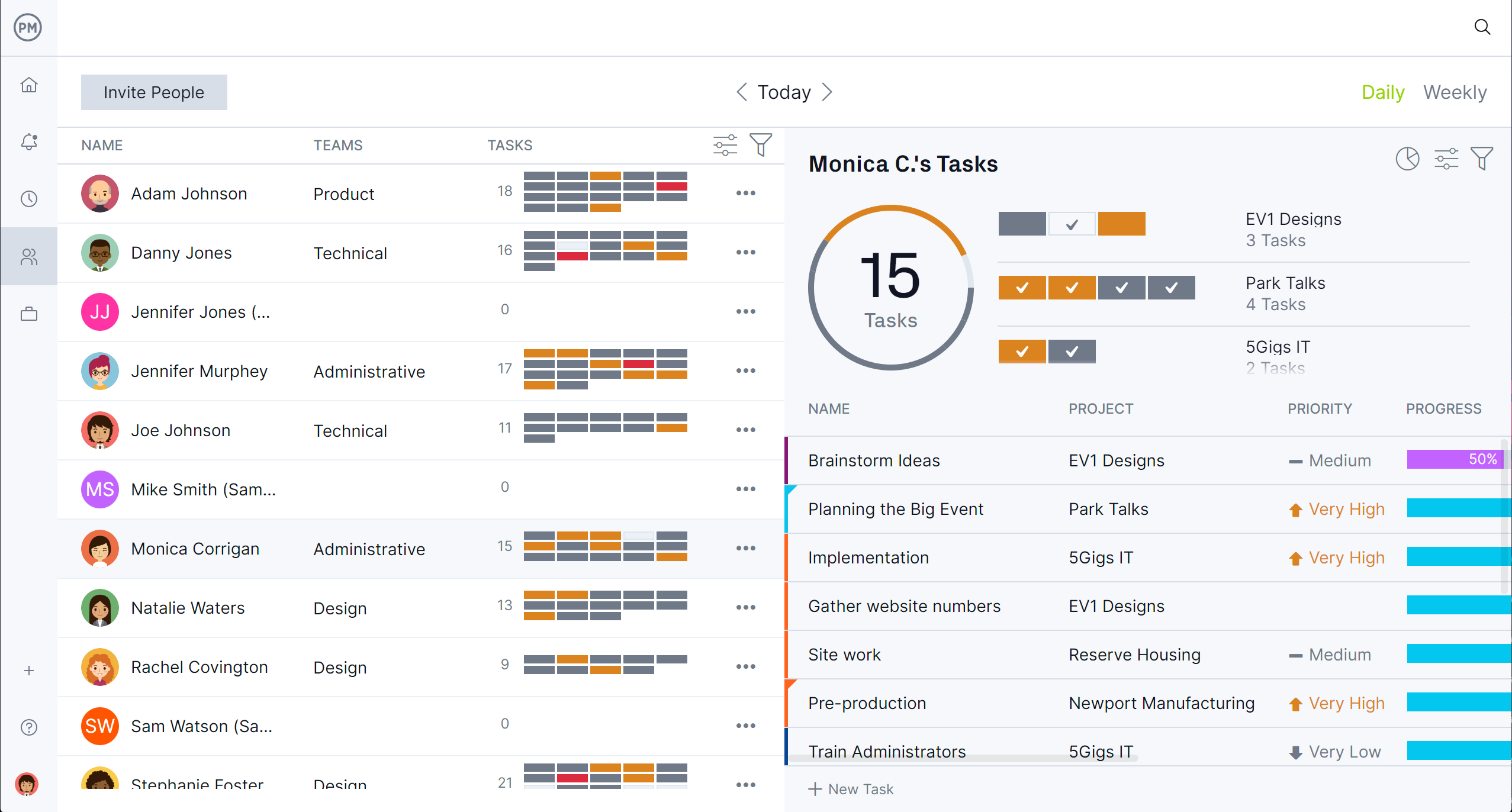
As a bonus, ProjectManager offers a seamless import and export of MPP files. If some team members still use Microsoft Project, it’s never been easier to collaborate on MPP files and project plans. It’s so simple that you might just convince them to make the switch to this Microsoft Project alternative, too. There isn’t a more powerful, yet easy-to-use software in this Microsoft Project alternatives list. See for yourself with a free 30-day trial.
Verdict: Best Microsoft Project Alternative for Project Management
ProjectManager Pros & Key Features
- Offers versatile views including Gantt charts, kanban boards, task lists and calendars, allowing teams to visualize and manage projects in the style that best fits their workflow and preferences
- Robust planning, scheduling, tracking and resource management tools enable detailed project planning with task dependencies, critical path analysis, real-time progress tracking and efficient allocation and leveling of resources to optimize productivity
- Fully accessible via web browsers on Mac devices, ProjectManager provides secure cloud storage without file limits, ensuring seamless collaboration and easy access to documents from anywhere
- Enables users to import, view, and edit Microsoft Project files, making it a great bridge for teams transitioning from or collaborating with Microsoft Project users
- Equipped with features tailored to support complex project hierarchies, portfolio oversight and multi-project coordination, making it a strong choice for formal PMO environments
- Offers a risk-free opportunity to explore the software’s full range of features before committing, helping teams evaluate fit and usability
- Mobile apps for Android and iOS ensure users can manage tasks, update progress and communicate on the go, keeping projects on track even when away from the desktop
ProjectManager Cons & Limitations
- While reporting tools are robust, some users find the customization options restrictive when trying to generate highly specific or unique reports
- Although useful, the mobile app doesn’t offer the full suite of desktop functionalities, which can limit productivity when working solely from mobile devices
- Fewer integrations than other Microsoft Project alternatives in this list
- No free plan to test out the software before making a purchase, though there is a 30-day free trial
ProjectManager Pricing
- Team: $14.00 user/month, billed annually
- Business: $26.00 user/month, billed annually
- Enterprise: contact sales for a custom quote
ProjectManager Reviews
- G2 review: 4.4/5
- Capterra review: 4.1/5
- GetApp review: 4.1/5
Highlighted User Reviews
- “ProjectManager works very well with both large and small-scale projects. Being able to use this with anything from a project involving only two members of staff, to hundreds, has been invaluable.” Peter W – from Capterra
- “We used to manage our projects, resources, and reporting in different systems. Enter ProjectManager. We have consolidated systems and work more efficiently.” Jeffrey M – from Capterra
- “Having the full scope of activities and who is responsible to do it, plus the time tracking is excellent.” Flavio M – from G2
- “It has an excellent accounting system capable of calculating the time that a person has used to develop a task that was assigned to him, I like being able to collaborate with all my colleagues in the Finance sector through ProjectManager.” Jesus C – from G2
- “The UI of the application is user-friendly, and it helps to identify what we are looking for with minimal effort.” Pavan H – from G2
- “It’s a solid platform and has very good customer service. you can send collaboration invitations to your customers or partners, without the need for a setup or anything extra. What I like is that the website is always online, does not fall and is easy and intuitive to manage.” Aleksei V – from GetApp
2. Wrike
![]()
Wrike is an MS Project alternative that makes our list because it’s easier to use than Microsoft when planning, tracking and analyzing projects. It’s far more collaborative than MS Project, but then almost all the Microsoft Project alternatives on this list are too. You can easily invite freelancers, contractors, clients and teams from other departments into the tool for free, which is a nice touch.
Related: Best Wrike Alternatives: Free & Paid Options Ranked
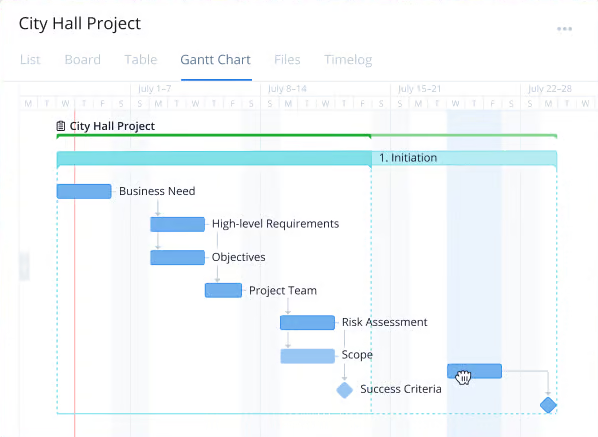
Those planning and collaborative features are great, but you’ll need a good deal of time to get comfortable using them. Don’t forget to add training time to your projects to get everyone up to speed with using Wrike. That doesn’t mean it’s hard to use, just difficult to know which is the right plan for you to move forward with. There are the pricing tiers we outline below, but then they have industry-specific versions of the software that add to the confusion. It’s an expensive project management tool, with user minimums, which might stop users from even exploring it as an option.
Verdict: Best Microsoft Project Alternative for Project Planning
Wrike Pros & Key features
- Allows users without a Wrike license to view and interact with project visuals, making it easy to share progress and updates with clients, stakeholders or external partners without extra licensing costs
- Offers versatile project visualization options including Gantt charts for timeline management, intuitive calendars for deadline tracking and customizable task boards (kanban-style) for agile workflow management
- Provides a robust free trial period, enabling teams to explore all core functionalities before committing to a subscription
- Includes a free tier with essential project management features, ideal for small teams or individuals who need basic tools without upfront costs
- Supports project management on the go with well-designed mobile apps available for both Android and iOS, ensuring seamless updates and communication anytime, anywhere
Wrike Cons & Limitations
- Wrike’s feature set leans more toward general work management and collaboration rather than the deep, specialized project management functionalities that complex projects often require, which limits its suitability for detailed, large-scale project planning
- While Wrike includes Gantt charts, they miss key capabilities such as integrated cost tracking, detailed resource allocation and workload balancing, making it less effective for comprehensive production or project scheduling needs
- Compared to more robust platforms like Microsoft Project, Wrike offers fewer options for customizable project tracking, detailed analytics and comprehensive reporting, which can hinder project visibility and informed decision-making
- Wrike’s pricing plans require a relatively high minimum number of users, which can be cost-prohibitive and inflexible for small teams or organizations looking for scalable solutions
- Wrike’s extensive feature set comes with a non-intuitive interface that can overwhelm new users and require significant time investment in training, potentially slowing down adoption and productivity
Wrike Pricing
- Free: $0 user/month
- Team: $10.00 user/month
- Business: $25.00 user/month
- Enterprise: contact sales for a custom quote
- Pinnacle: contact sales for a custom quote
Wrike Reviews
- G2 review: 4.2/5
- Capterra review: 4.4/5
- GetApp review: 4.4/5
Highlighted User Reviews
- “Wrike has become essential in my day and keeps me organized and on top of my tasks.” Paige T – from G2
- “Productivity has been enhanced by removing essential but repetitive chores.” Denise S – from G2
- “It’s a much simpler system compared to the likes of JIRA. It’s great for smaller teams and it’s much quicker and faster to load.” Mohammed M – from GetApp
3. Smartsheet
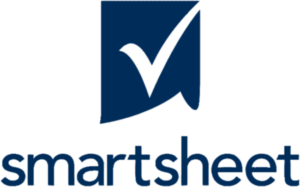
Smartsheet is an online MS Project alternative that functions like a spreadsheet but adds collaborative features that connect teams. Its focus on collaboration means that the scheduling and task management features are lighter than some might want, but they’re not absent from the tool. It’s powerful like MS Project but more customizable, supporting automation.
Related: Best Smartsheet Alternatives: Free & Paid Options Ranked

However, because of its limited reach in terms of managing projects, users will have to spend extra to get such tools as time tracking, budgeting and resource management. There are no real-time updates, and autosave can be a little slow, which is frustrating if you lose data before it has been saved. If you need advanced project management features, you’ll need to look for other MS Project alternatives.
Verdict: Best Microsoft Project Alternative for Spreadsheets and Templates
Smartsheet Pros & Key Features
- Smartsheet is ideal for teams and organizations moving beyond basic Excel spreadsheets, offering familiar grid-like interfaces combined with powerful project management features that enhance collaboration and control
- Allows users to easily export files directly to Microsoft Excel and Microsoft Project formats, ensuring smooth data transfer and compatibility with established enterprise tools
- Provides full functionality and consistent performance on Mac devices, making it a reliable choice for Mac users seeking an alternative to Microsoft project management software
- Offers a free trial period, enabling users to explore its extensive features and determine if it fits their project needs without any upfront commitment
- The mobile app for both Android and iOS empowers users to manage tasks, update projects and communicate with teams anytime, anywhere, ensuring productivity even when away from the desk
Smartsheet Cons & Limitations
- While Smartsheet covers some project tracking needs, it lacks advanced features like built-in critical path analysis, earned value management and comprehensive scheduling logic found in Microsoft Project
- Many of Smartsheet’s advanced functions require users to manually input and understand spreadsheet-like formulas, which can significantly raise the learning curve—especially for teams unfamiliar with Excel logic
- Compared to Microsoft Project and other enterprise-grade alternatives, Smartsheet offers limited resource planning and workload balancing features, making it less suitable for large teams managing complex allocations
- While helpful for surface-level visibility, Smartsheet’s reporting and dashboard features fall short in delivering the granular insights and high-level rollups needed for program or portfolio management
- Smartsheet does not offer a permanent free version—users must upgrade after the trial, which may be a barrier for small teams or startups with limited budgets
- As projects scale and more data is added to Smartsheet grids, users often report slower load times and interface lags, which can disrupt workflows and productivity
Smartsheet Pricing
- Pro: $9 user/month, billed annually
- Business: $19 user/month, billed annually
- Enterprise: contact sales for a custom quote
- Advanced Work Management: contact sales for a custom quote
Smartsheet Reviews
- G2 review: 4.4/5
- Capterra review: 4.5/5
- GetApp review: 4.5/5
Highlighted User Reviews
- “Smartsheet has allowed me to take my to-do list and run with it in a way that I didn’t think would be possible.” Victoria W – from G2
- “I like that Smartsheet has a lot of different functions. It can be used for project management, inventory or event planning.” Lauren M – from Capterra
- “SmartSheet is my go-to for project tracking and timelines. It’s like Excel but way smarter. Super flexible for team work too.” Michael J – from GetApp
4. Primavera P6
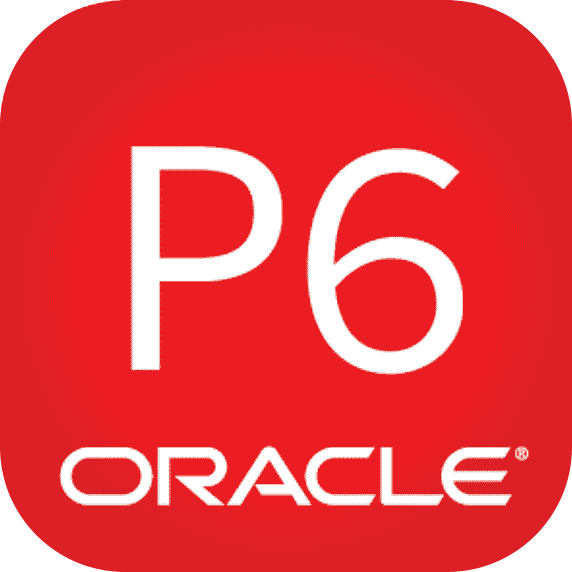
Primavera P6 is project management software developed by Oracle and used for enterprise portfolio management. It’s a Microsoft Project alternative that is best suited for large-scale and complex projects, often found in construction, engineering and manufacturing. It’s useful for projects that require extensive scheduling, resource management and detailed reporting. In terms of scheduling, there are Gantt charts, critical path analysis and more. For resource management, the software offers resource leveling, allocation and cost management.
Related: What Is Oracle Primavera P6? Uses, Features & Pricing
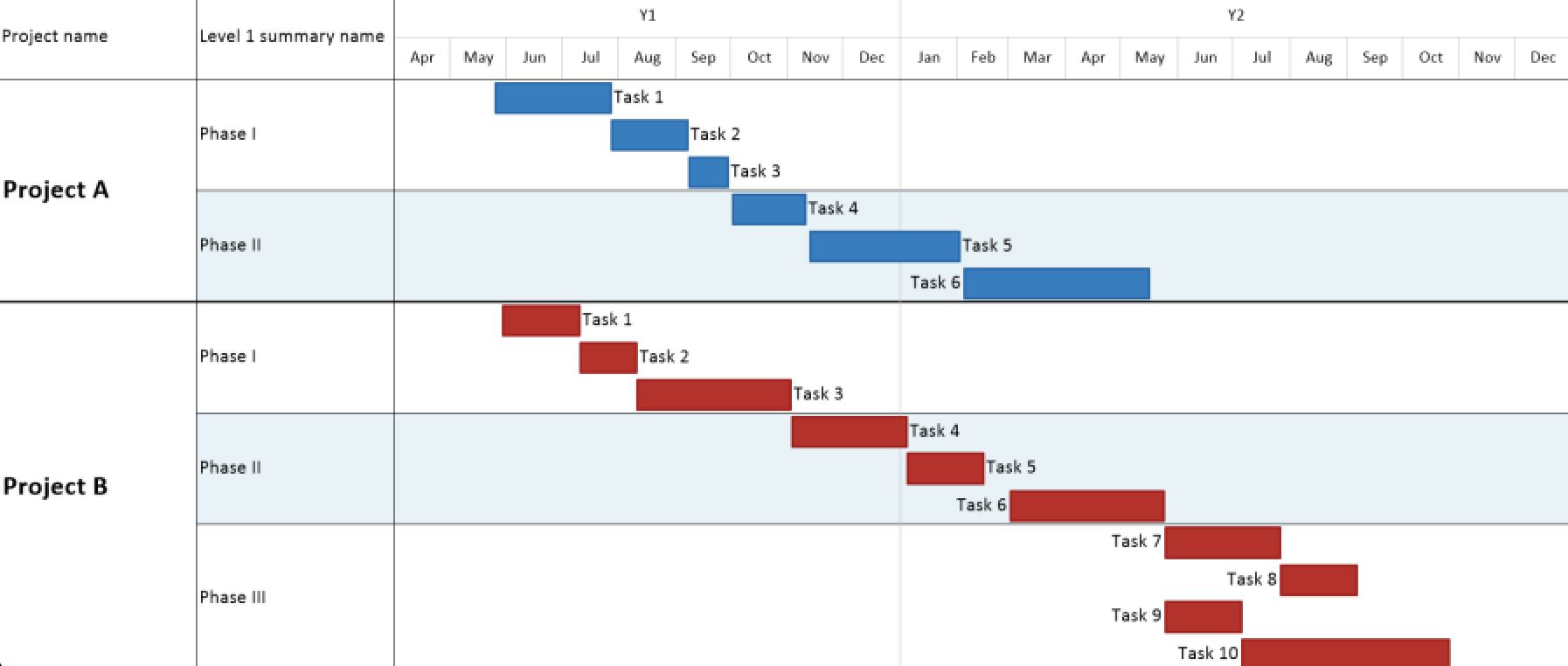
The trouble with this Microsoft Project alternative is that it’s complicated and has a steep learning curve, especially for new users. Be prepared to devote time for significant training before doing any project work. On top of this, the price of entry is high. This Microsoft Project alternative is more expensive than most project management software when extra licenses and implementation are required. It’s also resource-intensive. Expect substantial computing resources and infrastructure to support it, plus maintenance.
Verdict: Best Microsoft Project Alternative for Businesses
Primavera Key Features & Benefits:
- Primavera is built specifically for managing complex, large-scale projects across industries like construction, engineering and manufacturing, offering tools for project scheduling, resource optimization, cost control and risk management—often exceeding the depth of Microsoft Project for enterprise use cases
- With both on-premise (Primavera P6) and cloud-based (Oracle Primavera Cloud) versions available, organizations can choose the deployment method that best suits their IT infrastructure, data security needs and budgetary considerations
- Oracle Primavera Cloud enhances collaboration with features like robust scheduling, project prioritization, portfolio management and integrated cost and risk analysis—all accessible via the web, making it a scalable solution for remote teams
- Primavera’s mobile app for Android and iOS enables users to update progress, check schedules and manage tasks directly from the field—ideal for construction and infrastructure teams that need real-time access
- Primavera supports multiple concurrent users and complex project environments with highly configurable role-based permissions, making it ideal for cross-functional teams and large organizations managing interdependent projects
Primavera Cons & Limitations:
- Oracle’s support model often routes users through formal ticketing systems or knowledge bases, which can be frustrating when users need real-time assistance or direct customer service, especially for mission-critical issues
- Compared to modern project management tools, Primavera’s interface—particularly in the P6 version—feels clunky, with a steep learning curve and non-intuitive navigation that may deter new users or non-technical stakeholders
- Primavera is known for its dense functionality and enterprise-level architecture, but this power comes at the cost of usability. Many teams find it difficult to get started without formal onboarding, consulting, or certifications
- Accessing comprehensive, clear and up-to-date product documentation can be a challenge, which hampers user onboarding, troubleshooting and effective configuration without external help or paid training
- Primavera is priced and licensed for enterprise use, with high per-user costs, additional fees for integrations and training and ongoing maintenance requirements, making it inaccessible for smaller teams or startups
- While Primavera supports some integrations, it’s not as open or flexible as other modern platforms when it comes to third-party app support or plug-and-play integrations, requiring more manual work or custom API development
Primavera Pricing
The pricing for Primavera products in this blog comes from the Oracle Primavera Global Price List.
- Primavera P6 Enterprise Project Portfolio Management: $2,750 license price, plus an additional $605 fee for software update license & support
- Primavera P6 Progress Reporter: $950 license price, plus an additional $209 fee for software update license & support
- Primavera P6 Professional Project Management: approx. $2,500 license price, plus an additional $550 fee for software update license & support
Primavera Reviews
- G2 review: 4.4/5
- Capterra review: 4.4/5
- GetApp review: 4.4/5
Highlighted User Reviews
- “Oracle Primavera Cloud is very user-friendly, has amazing management and scheduling tools which allows good coordination between the team and also saves money and time.” Bruno L – from Capterra
- “Accurate calculation and output data is perfect.” Sameh H – from Capterra
- “The ability to build huge and complex schedules. P6 has been the construction scheduling standard for a while now. The ability to handle the thousands of activities in a large project and adjust to the constant changes of the construction industry.” Blake B – from GetApp
5. Monday.com
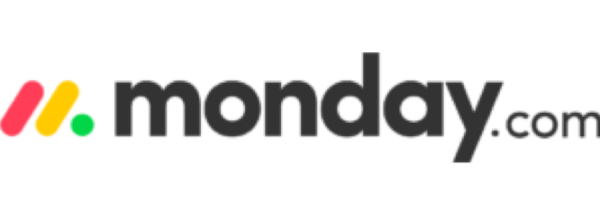
Monday is a Microsoft Project alternative that is fun to use, which makes it nearly the polar opposite of Microsoft Project. Monday is a project management software that doesn’t feel like a project management software. It is easy to start customizing workflows, and it has automation to keep users aligned and updated on due dates. Agile users will love the kanban boards for task management and the custom dashboard that tracks progress in real time.
Related: Best Monday.com Alternatives: Free & Paid Options Ranked
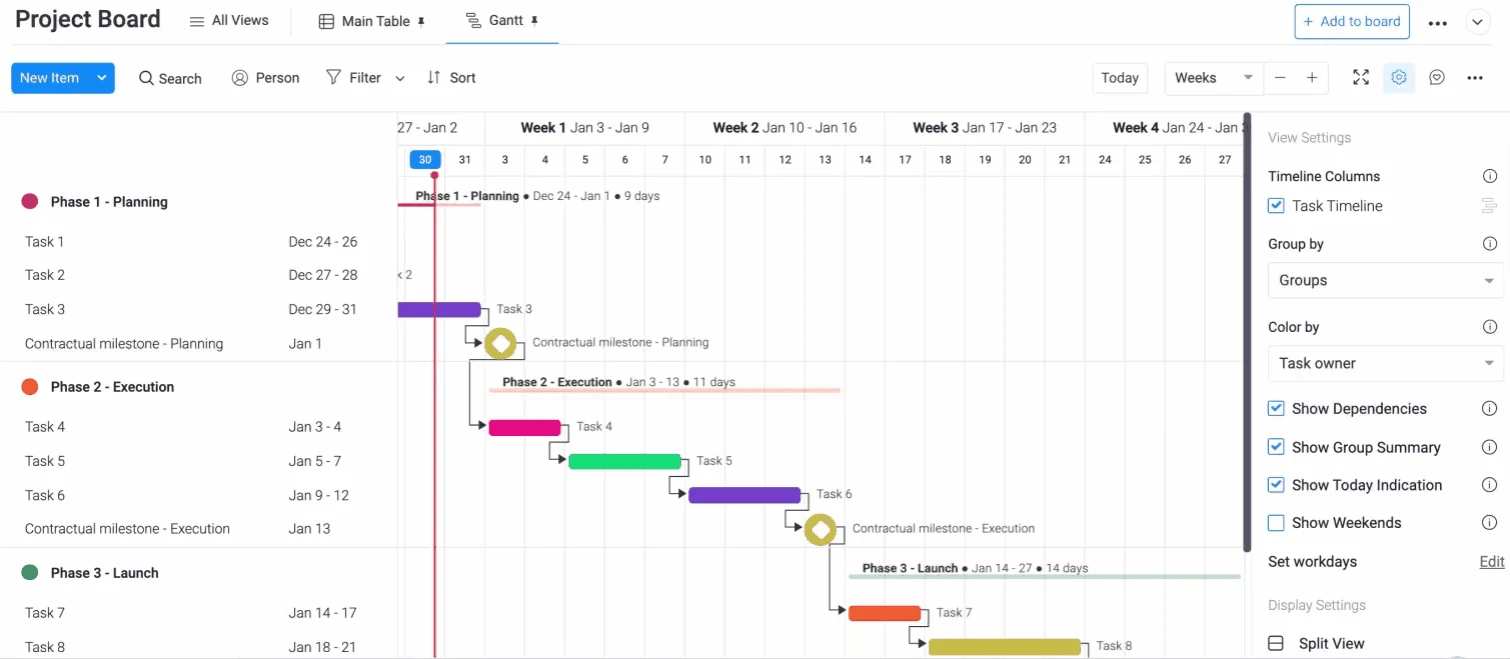
If all this sounds like a good MS Project alternative and you want to check it out, you’ll only have two weeks to play around with the trial version or use the free edition, which is limited to two users. That’s not really enough time to get a handle on an app. More a collection of customized spreadsheets than project management software, Monday might fall short of your management needs. For example, there’s no Gantt chart. The timeline they offer is a lightweight attempt to match the power of the Gantt. There are no dependencies, for one, which is sure to cause headaches as you execute your project. But if you’re looking for simple MS Project alternatives, this could be it.
Verdict: Best Microsoft Project Alternative for Ease of Use
Monday.com Pros & Key Features
- Designed with a clean, visual interface that’s perfect for first-time project managers and cross-functional teams seeking quick onboarding without extensive training
- Offers seamless communication through comment threads, mentions, file attachments and real-time updates—ideal for distributed teams managing complex timelines
- Allows teams to track project progress, update tasks and receive notifications while in the field or working remotely, ensuring productivity on the go
- Try premium features for a limited time with no obligation, making it easy to evaluate capabilities before committing to a paid plan
- A solid starting point for small teams or startups, offering basic features for up to two users with access to task boards, limited automation and mobile functionality
Monday.com Cons & Limitations
- Not well-suited for complex project, program or portfolio management needs often required by large organizations or PMOs
- While it offers visual reports, they lack the customization, forecasting and drill-down capabilities found in tools like Microsoft Project
- Monday is better for task and workflow management than it is for managing dependencies, critical paths or detailed project schedules
- No native Gantt-style critical path or cost/resource tracking, which require third-party integrations or workarounds, limiting its appeal for advanced planners
- Automations and integrations often require higher-tier plans and users on lower plans may find the platform restrictive without paying more for premium functionality
- While the base price seems affordable, the requirement for a minimum number of seats and feature-based pricing tiers can quickly become expensive
Monday.com Pricing
- Free: $0.00 user/month
- Basic: $9.00 user/month, billed annually
- Standard: $12.00 user/month, billed annually
- Pro: $19.00 user/month, billed annually
- Enterprise: contact sales for a custom quote
Monday.com Reviews
- G2 review: 4.7/5
- Capterra review: 4.6/5
- GetApp review: 4.6/5
Highlighted User Reviews
- “We used to have a mess of excel sheets and emails but now everything’s in one place.” Laura A – from G2
- “It is overall a great product but it requires a lot of setup initially to take advantage of all its functions and features.” Ana D – from Capterra
- “It has a user-friendly interface. And it’s also great for collaboration, like assigning tasks and file sharing. And it’s pretty easy to use.” Andreas C – from GetApp
6. Asana
![]()
Asana is a great Microsoft Project alternative that organizes work across all your teams and makes sure everyone is always productive. It’s highly collaborative and tracks tasks and workflows, which makes it an ideal tool for task management. It’s flexible in that regard, and it has some of the best communication tools on this list, including video messaging that can be shared with the team. There are also multiple project views, including kanban boards, lists and calendars.
Related: Asana vs. Microsoft Project: In-Depth Comparison
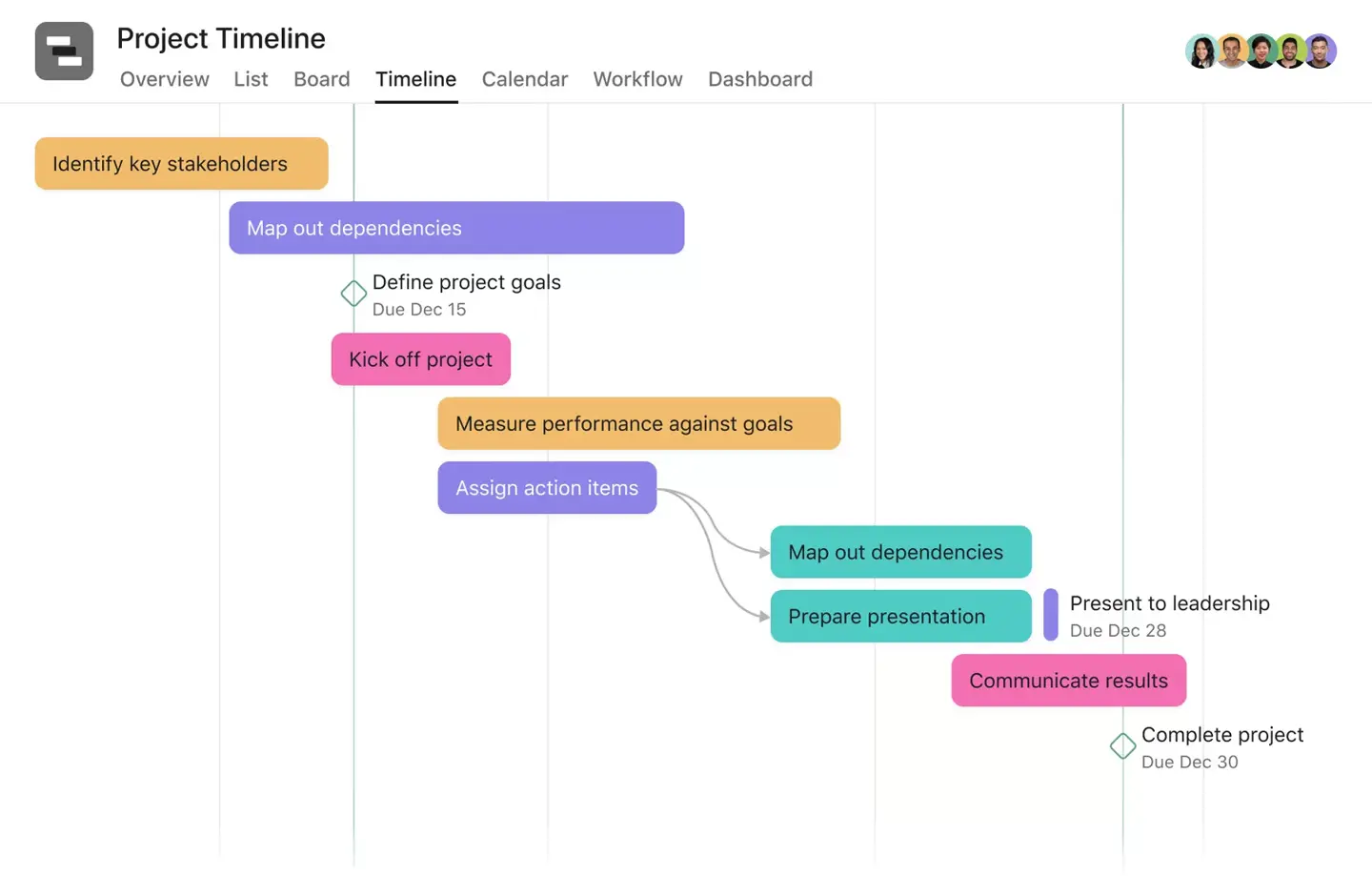
But, even with all its features and integrations, it still doesn’t mean Asana is a fully equipped Microsoft Project alternative. There are big holes in the platform. For example, there are no resource management tools, no budgeting and expense tracking and other things that project managers have come to expect in project management software. Projects that involve a lot of design work are not going to be happy that you can’t markup or proof visuals. But many will be won over by the design and flexibility when looking for Microsoft Project alternatives.
Verdict: Best Microsoft Project Alternative for Task Management
Asana Pros & Key Features
- Designed with simplicity in mind, making it easy for new users to adopt without extensive training, unlike Microsoft Project’s steeper learning curve
- Features like shared task lists, comment threads, real-time updates and notifications make cross-functional teamwork and communication intuitive and centralized
- The Android and iOS apps let users create, manage and update tasks and timelines on the go, ideal for remote and hybrid teams
- Free version includes core project management tools, making it a good Microsoft Project alternative for startups or small teams
- Connects with Microsoft Teams, Outlook and other productivity tools to streamline workflows across platforms
Asana Cons & Limitations
- Timeline view lacks advanced features, does not include critical features like cost management, capacity planning, or resource allocation that Microsoft Project supports natively
- Limited functionality for advanced project management lacks complex planning tools such as baseline setting, earned value management and multi-project dashboards
- Feature set is geared toward team-level collaboration and doesn’t scale well for enterprise-level project, program or portfolio management
- No built-in time tracking means Asana requires third-party integrations for time tracking, which adds complexity and cost
- Reporting and analytics tools are minimal, users looking for deep reporting and forecasting capabilities will find Asana’s tools lacking compared to Microsoft Project’s customizable reports
- More advanced automations or conditional logic require external apps or API workarounds, unlike Microsoft Project’s native automation options
Asana Pricing
- Personal: $0.00 user/month, billed annually
- Starter: $10.99 user/month, billed annually
- Advanced: $24.99 user/month, billed annually
- Enterprise: contact sales for a custom quote
Asana Reviews
- G2 review: 4.4/5
- Capterra review: 4.5/5
- GetApp review: 4.5/5
Highlighted User Reviews
- “Asana is very easy to use, intuitive for my team members who don’t have tech backgrounds but need to start and contribute right away.” Sara G – from G2
- “Overall, I had great success staying organized with this project management tool.” Mary B – from Capterra
- “I love how easy it is to share projects there, and one of my favorite features is having a template which can be applied to any project.” Yolandi E – from GetApp
7. Jira

Jira is a Microsoft Project alternative used for project management and issue tracking. It is mostly used in software development but can fit into other types of projects. It is not an apples-to-apples comparison with MS Project, but has similar capabilities, such as task tracking, workflow management and project planning. It can be customized and integrated with other tools and services. It is especially useful for teams working in an agile environment. It also has robust reporting and dashboards.

This Microsoft Project alternative is not ideal for projects run in a waterfall methodology. That’s because there are no Gantt charts, which are the tool of choice for traditional project management. The interface and many of its features, such as the kanban, are not easy to use. Cost can also be an issue if there are going to be multiple team members licensed to the product. Users have reported some performance issues, as well, when managing large projects. That can negatively impact productivity.
Verdict: Best Microsoft Project Alternative for Software Development
Jira Pros & Key Features
- Jira excels at tracking bugs, issues and tasks with customizable workflows tailored to software development and project management teams
- The Atlassian Marketplace offers thousands of plugins and integrations, allowing users to extend Jira’s capabilities to fit complex project requirements
- Built-in scrum and kanban boards help teams manage sprints, backlogs and workflows effectively
- Mobile apps for Android and iOS help teams stay connected and manage projects on the go
- Reporting tools provide insights into team performance, issue resolution times and project progress
Jira Cons & Limitations
- Lacks native Gantt chart functionality, which makes it difficult to visualize project timelines compared to other Microsoft Project alternatives
- User interface can be confusing and overwhelming, especially for new users or those not familiar with agile frameworks; navigating kanban boards is not always intuitive
- Steep learning curve for non-technical users, requiring significant time and training to get the most out of its features
- Customization can become complex and resource-intensive, making it difficult for smaller teams without dedicated admins to manage effectively
- Reporting and analytics tools, while powerful, can be complicated to configure and interpret for project managers unfamiliar with Jira’s ecosystem
- Limited built-in resource management and cost tracking features, forcing users to rely on third-party add-ons to fill critical gaps
Jira Pricing
- Free: $0 user/month
- Standard: $7.53 user/month
- Premium: $13.53 user/month
- Enterprise: contact sales for a custom quote
Jira Reviews
- G2 review: 4.3/5
- Capterra review: 4.4/5
- GetApp review: 4.4/5
Highlighted User Reviews
- “In my office we use jira for task management and time management, which helps us for team projects with multiple moving parts.” Saili K – from G2
- “Once we got past the learning phase, Jira significantly improved our project efficiency and collaboration.” Abu R – from Capterra
- “Jira is simple and fast to learn. It offers a lot of features and lets you personalize your Jira experience.” Raqel A – from GetApp
8. Microsoft Planner

If you love Microsoft software but feel that Microsoft Project is too much for you, then try Microsoft Planner. Glaringly, there are no Gantt charts, but if that’s not an issue, then this might be worth a try. This Microsoft Project alternative is a lightweight task management tool that specializes in kanban boards and task lists. And to help grease the wheels of collaboration, there are email notifications and calendars for those who need a work management solution.
Related: Best Microsoft Planner Alternatives: Free & Paid Options Ranked
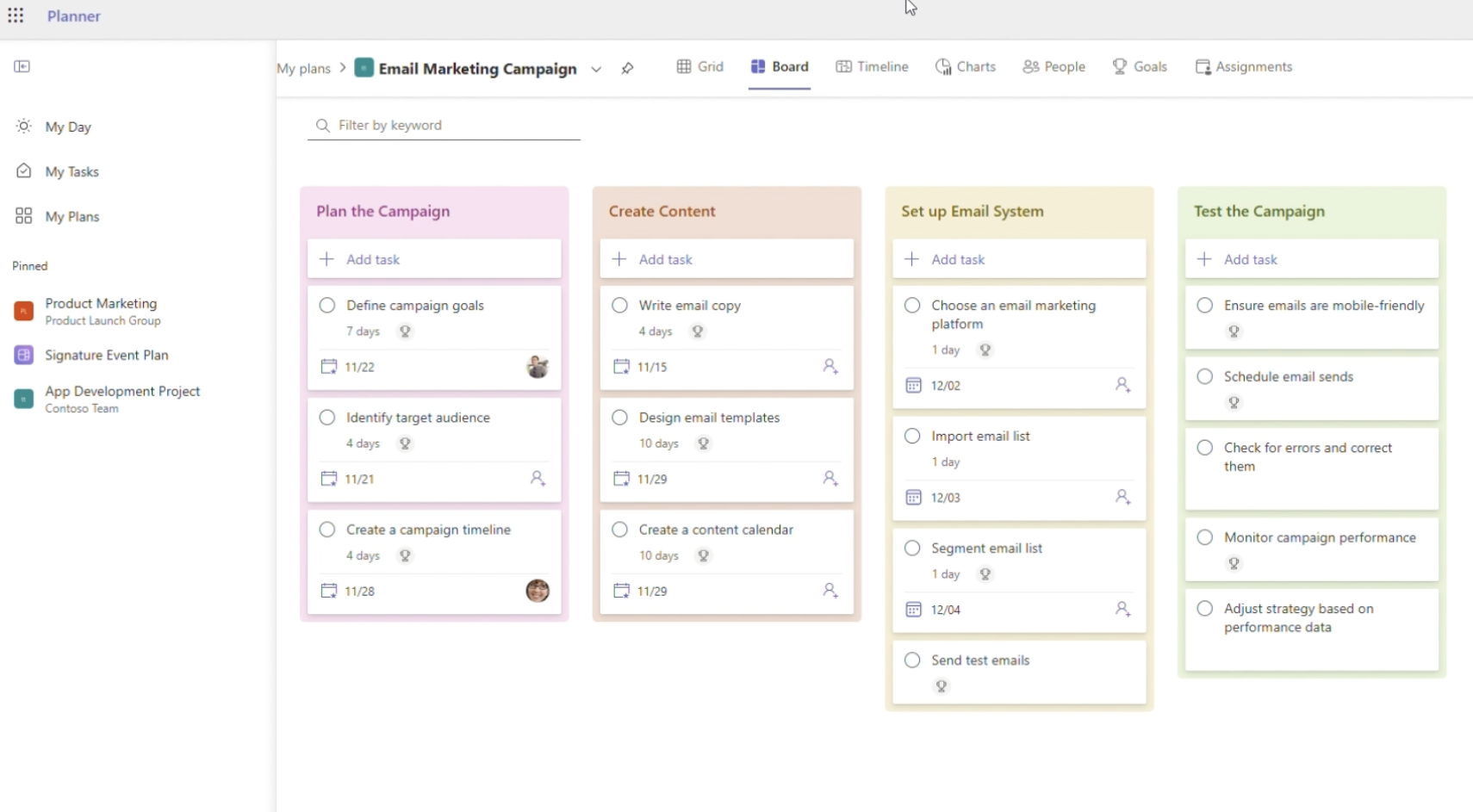
However, it’s a limited tool compared to Microsoft Project, and you’re certainly not going to get the planning and scheduling features of MS Project, much less its resource management and portfolio management features. But, if you just need an online space to manage tasks with your team and you live in the Microsoft universe, try Microsoft Planner instead.
Verdict: Best Microsoft Project Alternative for Microsoft Fans
Microsoft Planner Pros & Key Features
- Intuitive and user-friendly interface designed for quick adoption by teams of all sizes, making it easy to organize and manage tasks without a steep learning curve
- Seamless integration with Microsoft 365 ecosystem including Outlook, Teams and OneDrive, enabling smooth collaboration and file sharing within familiar tools
- Basic but effective task management capabilities such as task assignment, due dates, checklists and progress tracking to keep teams aligned on deliverables
- Visual task boards with drag-and-drop functionality that support kanban-style workflow management for enhanced team productivity and transparency
- Mobile apps for Android and iOS that allow users to stay connected, update tasks, and collaborate on the go
- Free trial available to explore core functionalities before committing, ideal for teams seeking a simple project management alternative without upfront investment
Microsoft Planner Cons & Limitations
- Lacks Gantt charts and advanced timeline views, limiting its usefulness for teams needing detailed project scheduling and dependency tracking
- No built-in workflow automation, making it less efficient for repetitive or complex task processes without integrating third-party tools
- Limited project management features overall, lacking resource management, cost tracking and comprehensive reporting capabilities
- Not suited for managing large or complex projects, as it doesn’t support portfolio management or multi-project views
- Minimal customization options for task views and fields, restricting how teams can tailor the software to their unique workflows
- Relies heavily on the Microsoft 365 ecosystem, which can be a barrier for organizations not fully invested in Microsoft products
- No native time tracking or budgeting tools, which limits its effectiveness for projects that require detailed financial oversight
Microsoft Planner Pricing
Before diving into the pricing plans available for Microsoft Planner, it’s important to understand there are two main versions of this software, Microsoft Planner Basic and Microsoft Planner Premium.
Microsoft Planner Basic
The version included in most Microsoft 365 subscriptions. Good for lightweight task management. Starts from $6 to $22 per user per month, billed annually. Price varies depending on the Microsoft 365 subscription.
- Microsoft 365 Business Basic: $6.00/user/month, billed annually
- Microsoft 365 Business Standard: $12.50/user/month, billed annually
- Microsoft 365 Business Premium: $22.00/user/month, billed annually
- Microsoft 365 Apps for Business: $8.25/user/month, billed annually
Microsoft Planner Premium
The next level up, for users or teams needing more advanced project management features.
- Planner Plan 1: $10/user/month, billed annually
- Planner and Project Plan 3: $30/user/month, billed annually
- Planner and Project Plan 5: $55/user/month, billed annually
For more detailed information about each of these Microsoft Planner plans and the features that are available for each pricing tier, visit our Microsoft Planner blog.
Microsoft Planner Reviews
- G2 review: 4.2/5
- Capterra review: 4.3/5
- GetApp review: 4.3/5
Highlighted User Reviews
- “Overall, my experience with Microsoft Planner has been very positive, as it has helped my team share tasks and establish procedures to follow.” Alvaro G – from G2
- “Microsoft Planner is great because it’s part of the Microsoft 365 family. It works really well with other Microsoft apps like Teams and Outlook, making it easy to use.” Anand G – from Capterra
- “I loved that I could set up a project plan and assign tasks to individuals. I also like that you can group tasks for different categories, including individuals, task type, priority, etc.” Nicholas B – from GetApp
9. Zoho Projects
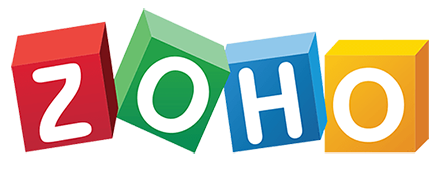
Zoho Projects is a Microsoft Project alternative with kanban boards that organize tasks, a social feed that captures updates on those tasks and forums for lengthier discussions. It connects teams to foster productivity and even has a timesheet feature for managers to see how much time each team member spends on their tasks. It offers issue tracking and a Gantt project view.

What it lacks as an MS Project alternative are resource management tools and reporting. In a sense, a manager is flying blind if they can’t generate status reports and then reallocate resources to keep their teams working at capacity. There is also no function for managing more than one project at a time, leaving the tool limited in what it can do for users.
Verdict: Best Low-cost Microsoft Project Alternative
Zoho Projects Pros & Key Features
- Zoho Projects offers core project planning features like task management, milestones and project timelines that are well-suited for smaller teams looking for a simple, intuitive alternative to Microsoft Project
- The mobile app makes it easy to manage tasks, track time and collaborate on the go, ensuring your team stays productive no matter where they are working from
- Zoho Projects provides a 10-day free trial for users to test premium features and a free plan with essential tools—ideal for individuals or small teams not ready to commit financially
- Unlike many basic project tools, Zoho Projects includes built-in time tracking, issue tracking and workflow automation tools, helping teams monitor productivity and streamline repetitive tasks
- It integrates easily with other Zoho apps (like Zoho CRM, Zoho Books) and third-party tools like Google Workspace, Slack and Microsoft Teams, offering flexibility in your software stack
Zoho Projects Cons & Limitations
- While feature-rich, the interface isn’t as polished or intuitive as some competitors, which can make onboarding and daily use more challenging, especially for non-technical users
- The Gantt charts in Zoho Projects provide basic timeline visualization, but lack more advanced features like critical path analysis, baseline comparisons and full dependency mapping offered by Microsoft Project
- Unlike Microsoft Project, Zoho Projects doesn’t provide in-depth tools for resource allocation, workload balancing or forecasting—making it less suitable for complex projects with large teams
- Although Zoho offers many integrations, setting them up—especially with third-party or enterprise tools—can be clunky or require additional configuration, limiting its plug-and-play convenience
- Zoho Projects lacks the high-level reporting, roll-up dashboards and portfolio planning tools needed by PMOs or teams managing multiple projects simultaneously
- Custom workflows, fields and reporting are available but not as deep or flexible as what’s offered in Microsoft Project or other enterprise-level alternatives
Zoho Projects Pricing
- Free: $0 user/month, up to five users
- Premium: $4.00 user/month, billed annually
- Enterprise: $9.00 user/month, billed annually
- Projects plus: contact sales for a custom quote
Zoho Projects Reviews
- G2 review: 4.3/5
- Capterra review: 4.5/5
- GetApp review: 4.5/5
Highlighted User Reviews
- “What I like most is how it integrates perfectly with the entire Zoho ecosystem.” Emy L – from G2
- “While the UI and the setup were slightly complicated, Zoho Projects helps you track your projects efficiently.” Shria G – from Capterra
- “It was excellent, I liked it, maybe in the future we will take it into account as our project manager. In the meantime we will use the free” Mario D – from GetApp
10. Airtable

Airtable is a cloud-based Microsoft Project alternative that combines elements of a spreadsheet with the functionality of a database. User-friendly and customizable, users can manage projects across multiple views, such as grid, calendar, kanban and gallery. Those already familiar with spreadsheets will find adapting to this tool easy, there are several pre-built templates for project management, content planning and CRM to help get teams started. It’s also collaborative, has automation for repetitive tasks and a mobile app for iOS and Android.

While there are multiple project views, there is no Gantt chart, which is a foundational project planning and scheduling tool, on any but the top-tier subscription accounts. In fact, its scheduling tools are generally limited. Even though it has some automation, this, too, is limited and might require third-party apps. Even its task management is problematic as setting up tasks and subtasks can be complicated. The Microsoft Project alternative also lacks resource leveling and can link all dependencies, which can create costly delays, and detailed reporting features. This tool simply isn’t suitable for large projects and those who do try it will find the cost prohibitively expensive.
Verdict: Best Microsoft Project Alternative for Building Apps
Airtable Pros & Key Features
- Airtable’s clean, spreadsheet-like interface is intuitive and easy to adopt, making it a good choice for users who want to quickly get started without a steep learning curve—unlike Microsoft Project’s more complex UI
- Multiple team members can edit and comment on projects simultaneously, enabling faster communication and real-time decision-making, especially helpful for remote and hybrid teams
- Users can link records between tables to create powerful relationships between project elements—great for tracking dependencies, budgets, or team responsibilities in a more dynamic way than Microsoft Project
- Airtable’s extensive library of templates for project tracking, product launches, content calendars, and more allows users to hit the ground running with minimal setup
- Easily toggle between grid, kanban, calendar, gallery and Gantt-style views to visualize data in the format that suits each team or project best—more flexible than Microsoft Project’s default Gantt-centric approach
Airtable Cons & Limitations
- While the free plan is generous, Airtable’s premium features—such as advanced automation, larger record limits and interface designer—require upgrading to more expensive tiers that can become costly for larger teams on a per-user basis
- Airtable places strict limits on the number of records per base depending on the plan, which can restrict teams managing large or complex projects with high data volume
- File attachment storage is capped per base and per plan, which can be a bottleneck for media-heavy projects or teams who frequently upload large documents
- Although Airtable is flexible, deep customizations often require scripting or third-party integrations, which can create a technical barrier for non-developers
- As teams grow, Airtable may lack the resource planning, detailed permission controls and portfolio-level reporting features needed for true enterprise project portfolio management
- Airtable relies on premium apps or third-party tools for advanced timeline views, workload management and resource tracking, which makes it less suited for complex scheduling or resource allocation
Airtable Pricing
- Free: $0 user/month
- Team: $20 user/month, billed annually
- Business: $45 user/month, billed annually
- Enterprise Scale: contact the sales team for a custom quote
Airtable Reviews
- G2 review: 4.6/5
- Capterra review: 4.7/5
- GetApp review: 4.7/5
Highlighted User Reviews
- “A lot of templates to start with. Highly customizable.” Jean D. – from Capterra
- “When you got a table up and running it was super effective.” Matt H. – from Capterra
- “I like how easily I can see data no matter how large. I can sort and create various views with ease.” Samantha P – from GetApp
11. Notion

Notion is a workspace tool that can be a strong Microsoft Project alternative depending on one’s needs. It’s an all-in-one workspace that combines note-taking, task management, database management and collaborative features. It has a more user-friendly interface than Microsoft Project, which is designed to be intuitive and doesn’t require a great deal of training.

Users who are looking for a Microsoft Project alternative with detailed Gantt charts, resource leveling and automated scheduling will be disappointed. Notion has limited advanced project management features. It’s also going to be a better fit for smaller teams or even individual use. Those looking to scale up to larger projects will become frustrated by Notion’s flexibility and look for a more specialized project management tool instead.
Verdict: Best Microsoft Project Alternative for Notetaking
Notion Pros & Key Features
- Notion allows users to build customized task boards, kanban views and calendars to manage to-dos, assign deadlines and track progress—making it a powerful yet approachable solution for personal and team project planning
- With its clean interface and block-based editing system, Notion excels as a centralized workspace for meeting notes, wikis, SOPs and brainstorming—all linked directly to related projects and tasks for seamless context-switching
- Users can build lightweight databases to track projects, clients, tasks or inventory—complete with filters, views, linked records and rollups—offering spreadsheet-like power with far greater flexibility and visual clarity
- From content calendars to CRM systems, Notion’s drag-and-drop interface and templating engine allow users to design fully personalized workflows, dashboards and layouts—without the complexity of traditional project management software
- Notion’s intuitive, minimalist design makes it approachable for users of all technical levels while still offering deep functionality for power users who want to go further
Notion Cons & Limitations
- Lacks built-in advanced project management tools such as Gantt charts, resource allocation and automated timeline tracking, making it less suited for complex projects requiring detailed scheduling
- Notion does not offer built-in time tracking or budget monitoring features, so teams need to rely on third-party integrations or manual workarounds for managing project costs and hours
- To implement workflow automation—such as task reminders, status updates or integration with other apps—users must connect Notion to external tools like Zapier or Make, adding complexity and potential costs
- As databases and pages grow in size and complexity, Notion can slow down significantly, leading to delays in loading times and affecting team productivity, especially for larger organizations
- While basic use is intuitive, mastering Notion’s relational databases, formula functions and advanced templates requires time and experience, which can hinder onboarding for new team members
- Export options are somewhat restricted, often leading to loss of formatting or data structure, which can complicate migration to other platforms or backup processes
Notion Pricing
- Free: $0 user/month
- Plus: $10.00 user/month, billed annually
- Business: $20.00 user/month, billed annually
- Enterprise: contact sales for a custom quote
Notion Reviews
- G2 review: 4.7 / 5
- Capterra review: 4.7 / 5
- GetApp review: 4.7/5
Highlighted User Reviews
- “I usually use it as a note taking, studying board, planner and even to organize my financial life – it is all my life in one place.” Fabiane C. – from G2
- “Originally a really good UI, available on multiple platforms, very dynamic and responsive.” Keith P – from Capterra
- “Love the easy to use interface, flexibility to create whatever tools you want, unlimited data and file uploads, Notion charts and automations.” Arjan S – from GetApp
12. Procore

Procore is a Microsoft Project alternative that is used in larger construction projects. It’s not a direct replacement for MS Project, as it’s focused on construction project management. However, it does have robust tools for managing project timelines, tasks and documentation, including scheduling, budgeting and resource management. Real-time collaboration keeps communication between general contractors, subcontractors and stakeholders, which reduces risks of misunderstandings and delays. There’s also a mobile app and integration with third-party tools.
Related: Best Procore Alternatives: Free & Paid Options Ranked

While the Microsoft Project alternative has Gantt charts and project calendars, these are the only scheduling tools available. Users might expect more views, considering the high cost of the product, which only increases when more users are added. Needless to say, this is not the software one is going to choose to run projects outside of construction. It’s simply designed for construction project management and little else. Like other complicated software products, this has a steep learning curve. Smaller projects, even small construction projects, are not going to be appropriate for this software. It would be overkill. One reason is that the setup and integration of Procore with existing systems is time-consuming and complex.
Verdict: Best Microsoft Project Alternative for Large Projects
Procore Pros & Key Features
- Procore is specifically designed to handle the complexities of large construction projects, offering robust tools to manage multiple sites, teams and subcontractors efficiently
- Easily store, organize and share critical project documents such as drawings, specifications, contracts and RFIs, ensuring all stakeholders have real-time access to the latest information
- Track budgets, commitments, change orders and actual costs in real time to maintain financial control and reduce cost overruns across complex projects
- Monitor labor hours, track workforce productivity and manage timesheets directly within the platform to optimize scheduling and payroll accuracy
- Works smoothly with Microsoft Project and Primavera P6, allowing for streamlined project scheduling and portfolio management across different platforms
- Fully featured mobile apps for Android and iOS empower field teams to update progress, submit reports and communicate instantly from anywhere on the job site
Procore Cons & Limitations
- Procore provides only two main project scheduling views—Gantt charts and project calendars—which may not satisfy users seeking more diverse or customizable visualization options like kanban boards or timeline views
- The construction scheduling features can be complex and overwhelming for new users, requiring significant time and training to fully leverage the platform’s capabilities
- Procore’s tools for resource allocation and workload balancing are limited, making it challenging to efficiently manage labor, equipment and materials across multiple projects
- While the Gantt charts offer task scheduling, they do not provide integrated cost tracking or budget insights at the task level, reducing financial visibility in project timelines
- Procore does not offer a free tier or trial, making it less accessible for small firms or teams with limited budgets looking to evaluate the software before purchase
- The pricing structure can be expensive and complex, often requiring custom quotes based on project size and features, which may deter smaller companies or startups
Procore Pricing
- Contact sales for a custom quote
Procore Reviews
- G2 review: 4.6 / 5
- Capterra review: 4.5 / 5
- GetApp review: 4.5/5
Highlighted User Reviews
- “Procore is a great tool for Construction professionals. The feature set is very tailored to construction related tasks.” Mark T – from Capterra
- “If you are willing to read and follow along with everything presented it will be incredibly helpful.” Mathew K – from G2
- “Management of projects with Procore is smooth and straightforward. You are able to share large volume data and documents. It’s a tool that enhances team collaboration.” Agasti S – from GetApp
13. Paymo
![]()
Paymo is comprehensive project management software with time tracking and invoicing capabilities so business owners and project managers can track project success. Its automatic time tracker makes Paymo a tough contender in the project management ring.
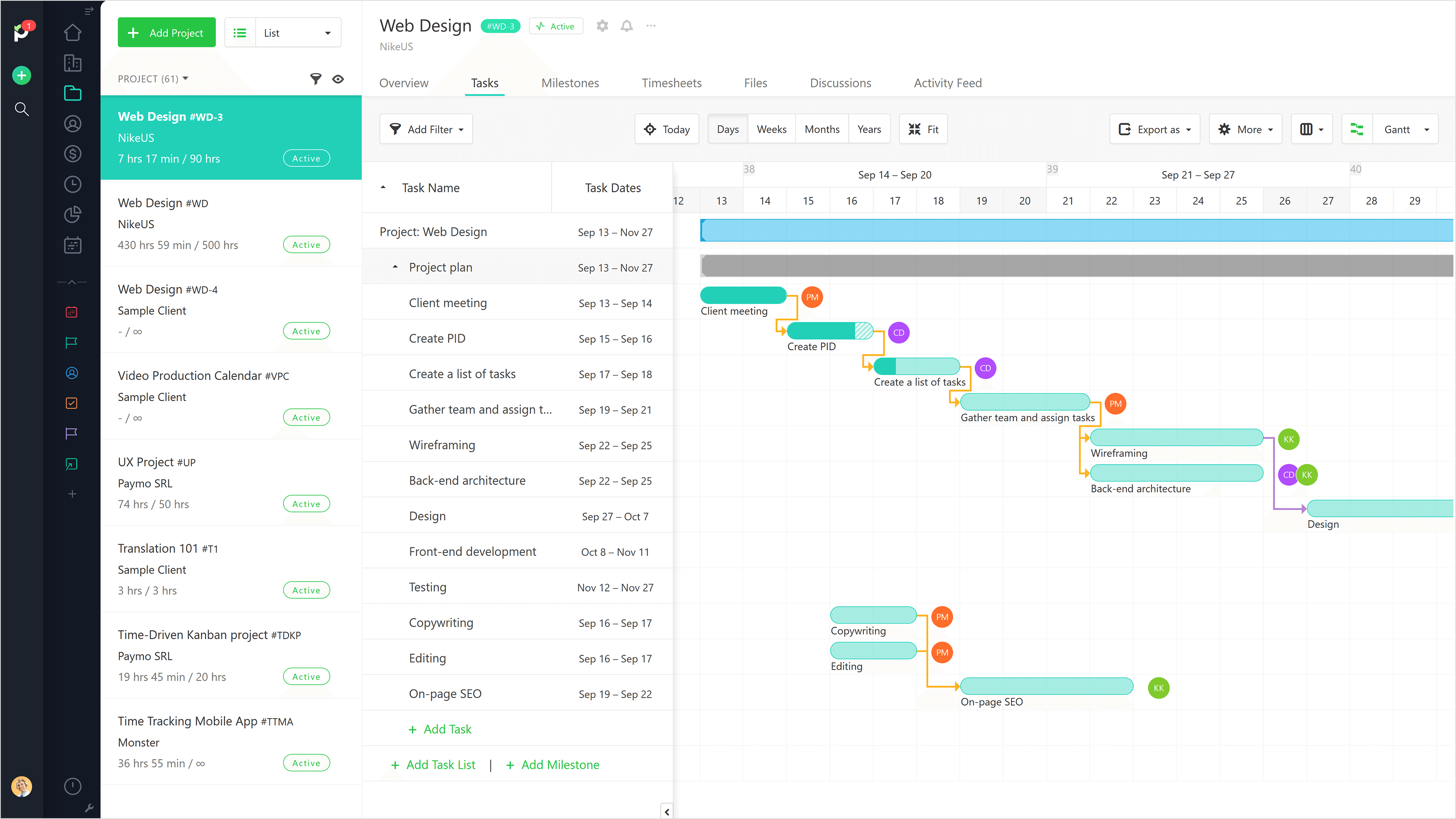
Task management is straightforward, with multiple assignees, priorities, customizable statuses, and project views including list, table, kanban, calendar and Gantt. There’s also an extra meta-Kanban view for a bird’s-eye view of your team’s tasks. This MS alternative is a great PM tool, but it has its limitations with third-party applications and can be complex and difficult to use.
Verdict: Best Microsoft Project Alternative for Project and Time Tracking
Paymo Pros & Key Features
- Multiple project management views including Gantt charts, task lists and kanban boards for flexible workflow visualization
- Integrated invoicing and payment processing, making it ideal for small businesses managing both projects and billing
- Comprehensive time tracking tools to monitor billable hours and improve productivity
- Collaborative features that allow teams to communicate and share files seamlessly within projects
- Mobile app for Android and iOS to manage projects and tasks on the go
Paymo Cons & Limitations
- Limited advanced resource management features, making it challenging to handle complex team workloads and allocations for larger projects
- Reporting tools are somewhat basic compared to more robust project management platforms, which can limit detailed insights and analytics
- No native integration with some popular enterprise tools, requiring workarounds or third-party apps for full workflow automation
- User interface can feel cluttered for new users, resulting in a steeper learning curve initially
- Mobile app, while functional, lacks some advanced features available on the desktop version, limiting on-the-go project management capabilities
- Limited customization options for workflows and project templates compared to other project management solutions
Paymo Pricing
- Free: $0 user/month
- Starter: $5.90 user/month, paid annually. Pricing goes up to $9.90 after the first 3 months
- Small Office: $10.90 user/month, paid annually. Pricing goes up to $15.90 after the first 3 months
- Business: $16.90 user/month, paid annually. Pricing goes up to $23.90 after the first 3 months
Paymo Reviews
- G2 review: 4.6/5
- Capterra review: 4.7/5
- GetApp review: 4.7/5
Highlighted User Reviews
- “Paymo has all the capabilities that allows me to save time by automating project and task management procedures.” Larry K – from G2
- “I like the way Paymo has been designed. With its straightforward menu sidebar, it’s easy to access everything your business needs quickly and easily.” Jamie Lee J – from G2
- “All the basics are well integrated from a simple task list to complex product road maps with the invoicing system / expenses that we can sync with our accounting software.” Adami T – from GetApp
14. ClickUp

ClickUp is a project management platform for teams across industries such as marketing, product planning and software development. It offers similar features to Microsoft Project, including Gantt charts, kanban boards, task lists and dashboards. Additionally, ClickUp offers document editing, instant messaging and email management tools. One of the main advantages of this software is the variety of integrations with third-party software, which allows users to customize the software to fit their needs.
Related: Best ClickUp Alternatives: Free & Paid Options Ranked

However, unlike Microsoft Project, ClickUp wasn’t exclusively designed for project management. As a result, some of its features are limited. For example, ClickUp’s Gantt charts don’t allow you to track project costs or the percentage complete of each task, and they don’t track the four types of dependencies that are used in project management. So while ClickUp it’s a versatile tool that can help you manage tasks, teams and workflows, it might not be the best Microsoft Project alternative.
Verdict: Best Microsoft Project Alternative for Team Productivity
ClickUp Pros & Key Features
- Comprehensive team collaboration tools, including a built-in email solution that streamlines communication without leaving the platform
- Highly flexible and customizable, making it suitable for diverse teams across various industries and project methodologies
- Robust Kanban boards, dashboards and multiple views tailored perfectly for scrum and agile workflows to boost productivity
- Advanced task management features such as priorities, dependencies and automations to simplify complex projects
- Seamless mobile project planning app available for Android and iOS, enabling teams to stay connected and manage tasks on the go
ClickUp Cons & Limitations
- The vast variety of features can be overwhelming and confusing for many users, especially during initial setup and onboarding, leading to a steep learning curve
- Lack several advanced features that power users find in Microsoft Project, such as in-depth resource allocation and cost tracking
- File exports are limited to PDF format only, which can restrict flexibility when sharing project data with other platforms or stakeholders
- The platform is missing comprehensive project reporting capabilities, making it harder to generate detailed insights or executive summaries without additional tools
- Despite a free plan, there is no dedicated free trial for the paid tiers, which can deter prospective users from fully testing premium features risk-free
- Performance can lag or become sluggish with very large or complex projects, affecting overall usability for bigger teams or long-term initiatives
ClickUp Pricing
- Free: $0.00 user/month
- Unlimited: $7.00 user/month, billed annually
- Business: $12.00 user/month, billed annually
- Enterprise: contact sales for a custom quote
ClickUp Reviews
- G2 review: 4.7/5
- Capterra review: 4.6/5
- GetApp review: 4.6/5
Highlighted User Reviews
- “Good for operational tasks and customer support.” Hovhannes G – from G2
- “ClickUp sits right in the middle between typical task management tools and business platforms.” Pawel M – from Capterra
- “ClickUp enables teams to stay in sync by facilitating collaboration on a single activity where all participants can see each other’s contributions, comments, and status updates.” Kelly M B – from GetApp
15. GanttPRO
![]()
If you’re a small team in need of a Microsoft Project alternative with Gantt charts, GanttPRO may be right for you. Like Microsoft Project, its primary feature is the Gantt chart, and you’ll find that it’s fairly robust when it comes to planning and scheduling. And, when compared to Microsoft Project, it’s quite easy to use. Plus, there’s a kanban board feature for those who aren’t comfortable using the Gantt.
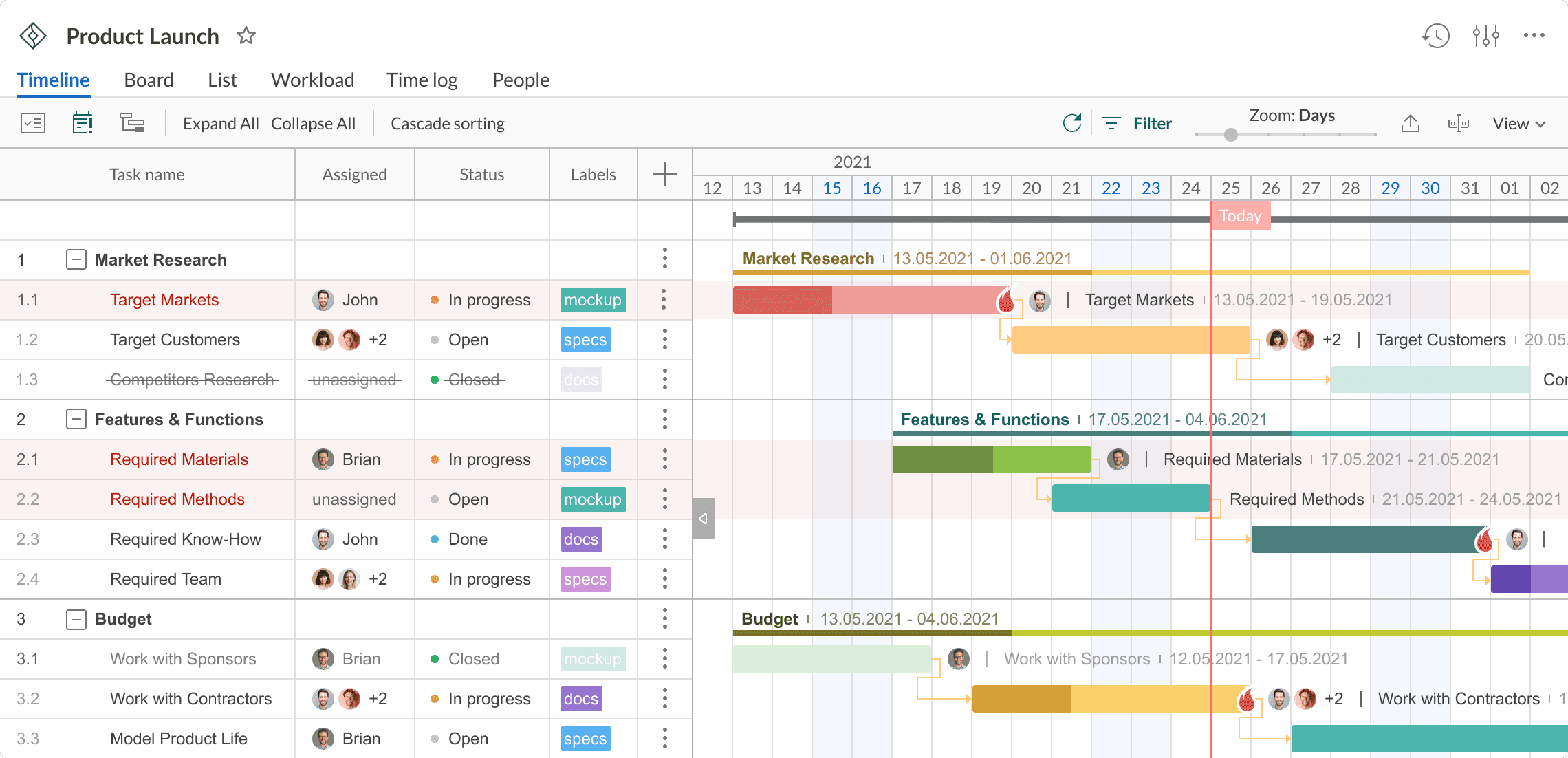
However, the Gantt is about all it does well. When it comes to tracking and reporting, it falls behind the pack. Furthermore, if you need to do billing or invoicing, you’ll have to rely on integrations to get it done. Unforutnately, its integrations aren’t very robust either, so you may find yourself using other tools in addition to this Gantt-heavy Microsoft Project alternative.
Verdict: Best Microsoft Project Alternative with a Gantt for Small Teams
GanttPRO Pros & Key Features
- Files can be exported in multiple formats, including PDF, PNG and Excel, making it easy to share project data across teams and stakeholders
- Projects are simple to view, share and edit with external collaborators, even if they use different software, thanks to its intuitive interface and import/export compatibility
- Robust cost and budget tracking tools allow project managers to set estimates, assign hourly rates and monitor actual costs against the budget in real time
- A fully functional 14-day free trial gives users access to all premium features, allowing teams to explore its capabilities before committing
- Mobile apps for both iOS and Android ensure users can manage timelines, tasks and updates on the go, enhancing flexibility for remote and field-based teams
GanttPRO Cons & Limitations
- No timesheets for logging hours in bulk, which makes it difficult for teams needing detailed time reports, although it does offer basic task-level time tracking
- Project reporting tools are limited, lacking in-depth project health reports, KPI dashboards or analytics for advanced project insights
- Very few native integrations with third-party apps, requiring reliance on tools like Zapier or manual workarounds to connect with other platforms
- No permanently free plan is available, which makes it less accessible for startups or individuals looking for long-term budget-friendly options
- Customization options are minimal, especially in terms of workspace layout, report configuration and workflow automation
- Not ideal for large-scale or highly complex projects, as it lacks advanced features such as portfolio management, resource leveling and baseline comparisons
GanttPRO Pricing
- Core: $7.00 user/month, billed annually
- Advanced: $10.00 user/month, billed annually
- Business: $17.00 user/month, billed annually
- Enterprise: Contact sales for a custom quote
GanttPRO Reviews
- G2 review: 4.8/5
- Capterra review: 4.8/5
- GetApp review: 4.8/5
Highlighted User Reviews
- “I especially enjoy the collaboration feature where I can invite colleagues to edit tasks and timelines in the live document. I have moved from using Google Sheets.” Glen K – from G2
- “GantPro software offers a seamless project management experience with its intuitive interface and robust features.” Dixie F – from Capterra
- “Extremely detailed and helpful for the project management of our college FSAE team. Could create a 14 month timeline with ease thanks to the great user interface. Helps assign and track tasks as well.” Kritik M – from GetApp
16. Trello

Trello is a tool that manages projects and helps teams collaborate. This software uses a kanban board interface that allows users to visualize their workflow. It provides transparency and fosters collaboration. It has real-time updates, which is a plus and has easy onboarding for teams. It’s a fun and easy-to-use MS Project alternative, which is why it made it number five on our list.
Related: Best Trello Alternatives: Free & Paid Options Ranked

But, as a fully-fledged Microsoft Project alternative, Trello falls short. It has a project bar chart instead of a Gantt. While that feature might try to mimic the usefulness of a Gantt it doesn’t set a baseline to track your actual progress against your planned effort, there are no inter-project dependencies and it can’t filter for the critical path in your schedule. Since it’s not the best project management software, Trello is recommended only for basic project management features.
Verdict: Best Microsoft Project Alternative for Kanban Boards
Trello Pros & Key Features
- Trello’s web-based platform and dedicated Mac app deliver a smooth, native experience on macOS, requires no complex installations or compatibility workarounds, allowing Mac users to effortlessly manage projects with full functionality, whether on desktop or mobile
- Flexible boards, lists and cards are suited for agile project management. Scrum teams can easily create sprints, track user stories, prioritize backlogs and visualize progress through customizable workflows and powerful automation — fostering collaboration and iterative delivery
- Connects with hundreds of popular tools such as Slack, Google Drive, Jira, GitHub, Microsoft Teams, Zapier and more. These integrations enable teams to centralize communication, automate repetitive tasks and sync data across multiple platforms, eliminating silos and streamlining project execution
- Mobile apps empower users to stay productive on the move. Whether updating tasks, commenting on cards or tracking project timelines, team members can maintain real-time collaboration and oversight from any location
- Teams can explore Trello’s premium features such as enhanced automation, advanced reporting and priority support through a free trial, enabling a hands-on comparison before committing financially
Trello Cons & Limitations
- Core functionality is relatively basic, lacking many advanced project management features such as detailed resource allocation, complex dependency tracking and built-in budgeting tools that are standard in more comprehensive platforms
- Visual approach is centered around kanban-style boards and simple calendars, which may not be sufficient for teams requiring Gantt charts, critical path analysis or comprehensive timeline views to manage complex, multi-phase projects effectively
- To match the depth of Microsoft Project’s capabilities, Trello users often need to invest in various Power-Ups (add-ons) or external integrations. This not only increases costs but can also introduce complexity and fragmentation, making it harder to maintain a unified project management system
- Lacks built-in features essential for PMOs or organizations managing multiple large-scale projects and portfolios, such as standardized governance, advanced reporting, resource pool management and compliance tracking
- Unlike Microsoft Project, which offers detailed, customizable reports and analytics for performance tracking and decision-making, Trello’s native reporting tools are minimal. This can hinder project managers’ ability to generate insights and demonstrate project status comprehensively without relying on external reporting tools
Trello Pricing
- Free: $0.00 user/month
- Standard: $5.00 user/month, billed annually
- Premium: $10.00 user/month, billed annually
- Enterprise: $17.50 user/month, billed annually
Trello Reviews
- G2 review: 4.4/5
- Capterra review: 4.5/5
- GetApp review: 4.5/5
Highlighted User Reviews
- “I use it at work for my daily tasks and I also use it at home for a variety of different things.” Michelle J – from G2
- “Aside from the UI being rather outdated, overall, Trello has streamlined our workflow significantly.” Peter Z – from Capterra
- “I used it in a company I was working at, and I also used it in a personal project, and both times it was a great tool.” Carina R – from GetApp
17. Basecamp

Basecamp is a Microsoft Project alternative that has team collaboration and is simple to use, two benefits that the notoriously uncollaborative and difficult MS Project can’t touch. Teams looking for a more straightforward and user-friendly solution to Microsoft Project will be attracted to this Microsoft Project alternative. It has task management features and communication tools, such as message boards, team chat and automatic check-ins. It creates a centralized hub for project collaboration.
Related: Best Basecamp Alternatives: Free & Paid Options Ranked
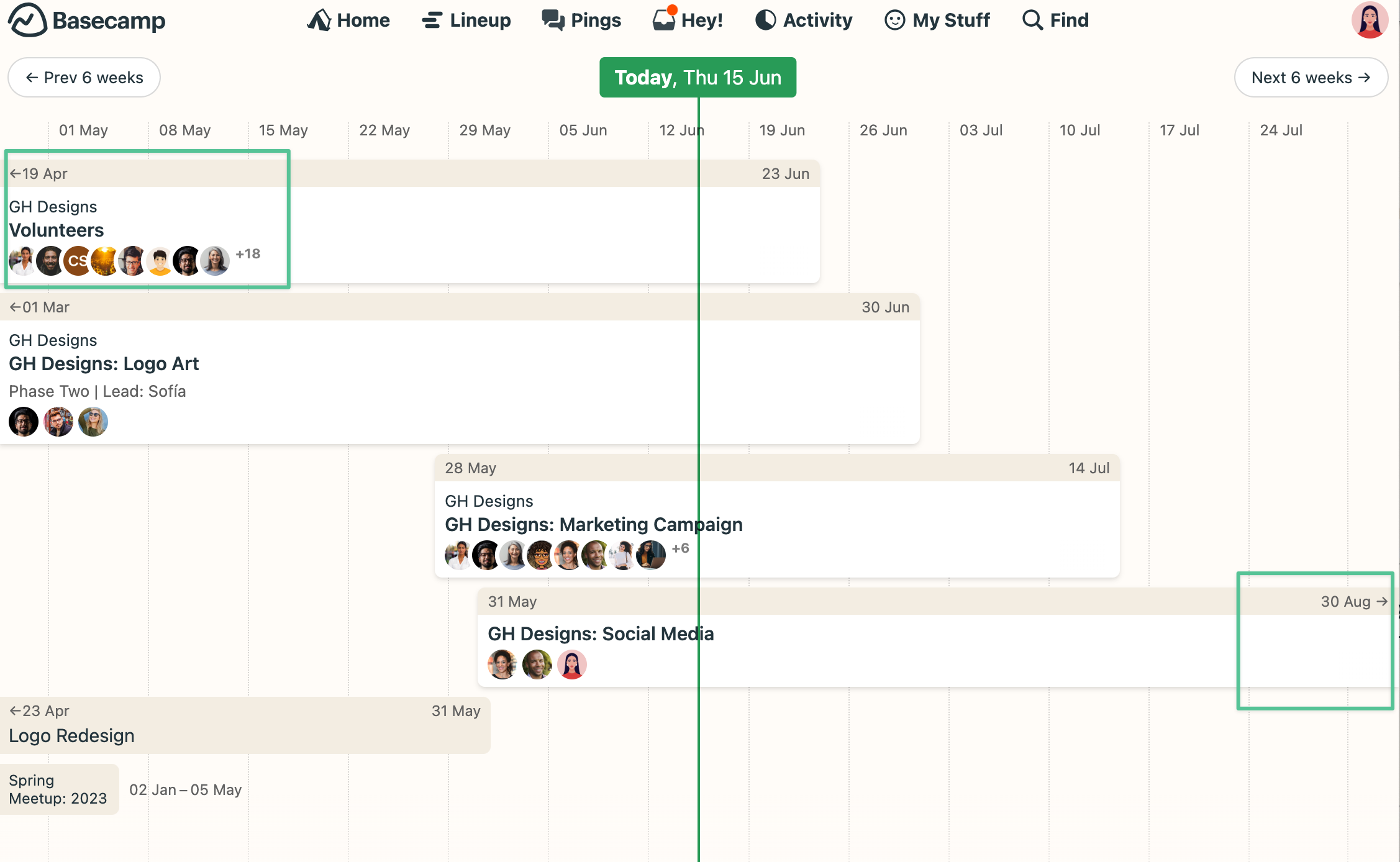
However, it falls short of being a holistic project management tool. That’s because it lacks Gantt charts and resource management features and can’t handle complex dependencies. This Microsoft Project alternative is not suited for projects with detailed scheduling and resource planning. Reporting is limited, which reduces the analytic capabilities that help guide project managers in their decision-making.
Verdict: Best Microsoft Project Alternative for Managing Everyday Work
Basecamp Pros & Key Features
- Straightforward interface that makes it easy to assign tasks, set deadlines and monitor progress. Its minimalist design removes the complexity often found in traditional project management software, enabling teams to focus on getting work done without a steep learning curve
- Mobile applications empower team members to stay connected, update tasks, communicate and manage projects from anywhere — ensuring seamless productivity regardless of location or device
- Pro Unlimited plan allows unlimited users at a fixed price. This makes it a cost-effective choice for growing teams and organizations aiming to scale collaboration without incurring escalating costs
- Integrates essential collaboration features such as message boards, group chat (Campfire), file sharing and automatic check-ins. These tools foster transparent communication and keep all project-related discussions, documents, and updates centralized and accessible
- Offers a free plan with essential project management and collaboration features, ideal for small teams or individuals just beginning to organize their work, providing a risk-free way to experience its core benefits
Basecamp Cons & Limitations
- Task management capabilities are quite simplistic compared to more robust project management platforms. It lacks the ability to create complex task dependencies, subtasks or customizable workflows, which limits its usefulness for projects requiring detailed task breakdowns and nuanced progress tracking
- Does not offer tools to allocate or optimize resources across projects effectively. This absence makes it difficult for project managers to track team member workloads, balance assignments or forecast resource availability, leading to potential bottlenecks or uneven task distribution
- Lacks built-in Gantt charts. Without this visual timeline representation, it becomes challenging to view task sequences, dependencies or overall project progress at a glance, limiting strategic planning and adjustment
- Reporting and analytics capabilities are minimal. It lacks customizable reports, dashboards or detailed insights into project performance, making it difficult for managers to analyze productivity trends, identify issues early, or make data-driven decisions
- Does not include native time tracking features. This forces teams to rely on third-party integrations or manual tracking, which can be inefficient and prone to inaccuracies, particularly when precise billing or time management is critical
- Offers very limited options for customizing workflows, notifications or automating repetitive tasks. This rigidity can hinder teams that want to tailor the platform to their specific processes or reduce manual work, reducing overall operational efficiency
Basecamp Pricing
- Basecamp Free: $0.00 user/month
- Basecamp Plus: $15.00 user/month
- Basecamp Pro Unlimited: $299.00/month, unlimited users
Basecamp Reviews
- G2 review: 4.1/5
- Capterra review: 4.3/5
- GetApp review: 4.4/5
Highlighted User Reviews
- “As a company, it allows us to flawlessly track all of our conversations, planning, tasks, and project progress.” Özgür K – from G2
- “The interface transforms complex functionalities into an intuitive experience for all users.” Tom G – from G2
- “Basecamp has single page projects that are relatively simple to use. The to-do lists are easy to use as well. Basecamp can also handle large file transfers.” David B – from GetApp
18. Teamwork
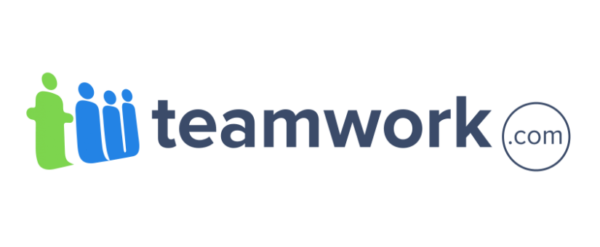
Teamwork is an easy-to-use Microsoft Project alternative. It organizes tasks and subtasks, labeling priorities and identifying dependencies to avoid bottlenecks. There are messages at the task level to connect teams as they work on their tasks and time tracking for managers to monitor progress. Like many Microsoft Project alternatives, it also features a Gantt chart view.
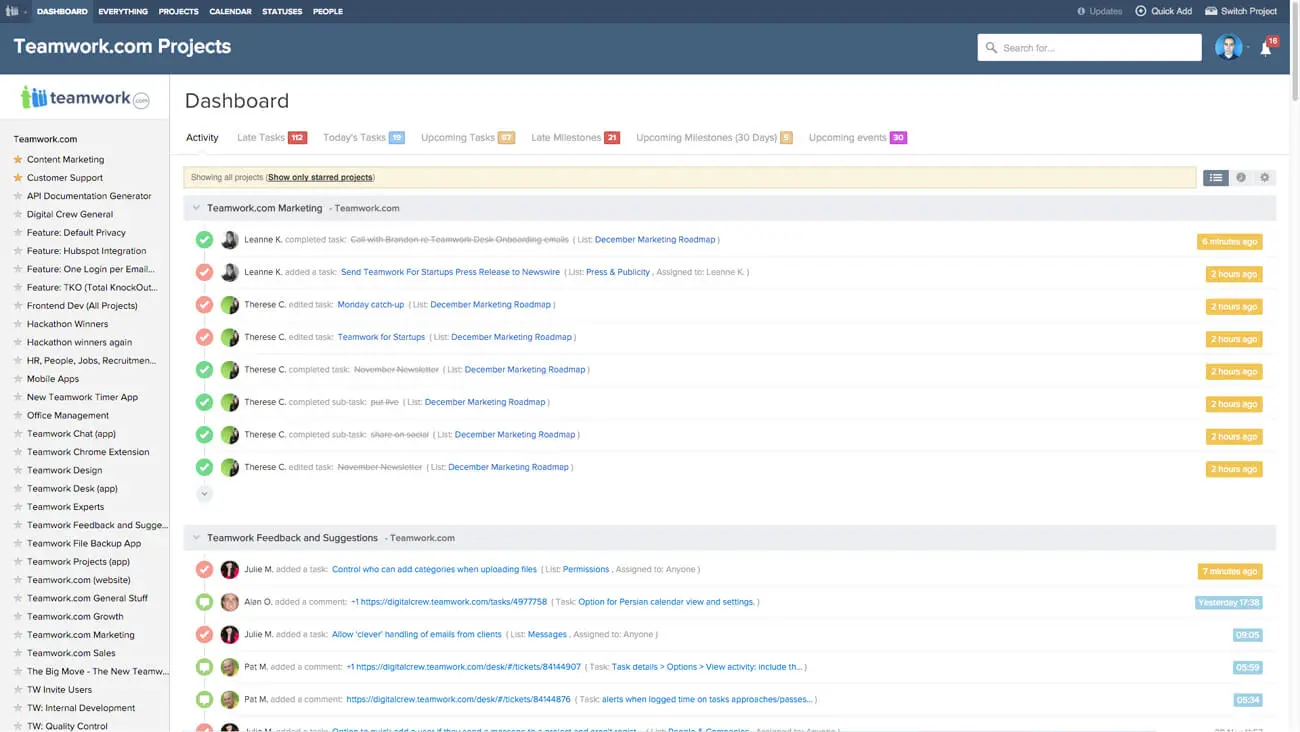
There’s a free version that has limited features. Reviewing all these apps shows the shortcomings of MS Project when it comes to teamwork, hence the name of this product. However, the tool isn’t great for every type of collaboration. For example, you can’t mark up files, which is a problem if teams are working on visual materials. But it’s still miles ahead of MS Project and other Microsoft project management software.
Verdict: Best Microsoft Project Alternative for Team Collaboration
Teamwork Pros & Key Features
- Goes beyond the fundamentals of task management by supporting task lists, subtasks, dependencies, milestones and priorities. Its clean interface and drag-and-drop functionality make it easy for teams to organize work without a steep learning curve, making it ideal for growing teams that need both structure and flexibility
- Includes native time tracking, timesheets and invoicing features. This integration streamlines project billing and resource management, allowing teams to log time, track billable hours and generate invoices without relying on third-party tools—especially valuable for client services, consultancies, and agencies
- Free trial that gives users access to many premium features, allowing teams to explore its capabilities before committing. This helps businesses assess its fit for their workflows without upfront investment
- Mobile apps available for both Android and iOS allow users to manage tasks, communicate with team members and track progress on the go. The mobile interface mirrors the desktop experience closely, making it easy for remote and hybrid teams to stay connected and productive from anywhere
- Workload management, project health status, portfolio views and client access permissions provide granular visibility into progress and resource allocation while enabling seamless collaboration with clients
Teamwork Cons
- Gantt chart views are best suited for basic task visualization rather than comprehensive project planning. The features lack the depth of more advanced tools—such as dynamic critical path analysis, baseline comparisons or full support for complex task dependencies—limiting their effectiveness for managing large-scale or highly interdependent projects
- Built-in reporting features cover the basics but fall short when it comes to advanced analytics. Customizable dashboards, detailed performance metrics and cross-project insights are limited unless you upgrade to higher-tier plans or rely on external integrations. This makes it harder for teams to make informed decisions based on real-time data across multiple projects
- Heavily geared toward professional services teams—such as agencies, consultancies and client-facing businesses—which can make it less adaptable for internal product teams, IT departments or engineering groups. This narrow focus may result in tools and workflows that don’t align with the needs of more general-purpose or cross-functional project teams
- One of the more rigid pricing policies is the three-user minimum on all paid Teamwork plans. This can be a barrier for freelancers, startups or small teams who need advanced features but are forced to pay for extra, unused seats, making it less cost-effective compared to more flexible pricing models offered by other platforms
- More powerful features—like workload management, billing or advanced permissions—can require a significant onboarding effort. Smaller or less tech-savvy teams may find themselves overwhelmed by the number of settings and configurations, slowing down initial adoption and productivity
- To unlock Teamwork’s full potential—including CRM, help desk or chat capabilities—users often need to rely on separate but related Teamwork products or third-party integrations. This can lead to a fragmented user experience and added costs, particularly for teams expecting an all-in-one solution out of the box
Teamwork Pricing
- Free: $0.00 user/month
- Deliver: $10.99 user/month, billed annually
- Grow: $19.99 user/month, billed annually
- Scale: Contact sales for a custom quote
Teamwork Reviews
- G2 review: 4.4/5
- Capterra review: 4.5/5
- GetApp review: 4.5/5
Highlighted User Reviews
- “It’s a great tool for unifying developers, designers and everyone involved in a project, needing little training.” Brett W – from G2
- “Can also be used for personal projects, tasks, planning and dreaming/distractions, to get the info out of your head and recorded in a central system.” Jacki B – from G2
- “Teamwork makes it super easy to handle repetitive task-and-project management procedures via real-time automation.” Oyekanmi O – from GetApp
19. GanttProject
![]()
GanttProject has one giant advantage over MS Project and even most of the Microsoft Project alternatives—it’s free. Gantt charts are the heavy lifters in project management and a free one is sure to be attractive. Especially one that’s easy to use and that can export documents to MS Project. That means this could prove a major asset to MS Project users.
Related: What Is GanttProject? Pros, Cons & Alternatives

That is also its deterrent. You’re still wedded to MS Project. Though, perhaps you’d use GanttProject all by itself to manage your project. After all, Gantt charts are great tools. The problem is that this Gantt is limited in what it can do. For this free MS Project alternative, you’re going to have to use a suite of other apps to get the project management features that MS Project offers.
Verdict: Best Free Microsoft Project Alternative for Gantt Charts
GanttProject Pros & Key Features
- Its open-source nature makes it ideal for developers, educators, and organizations seeking a no-cost, license-free solution that they can modify or extend based on their specific project needs or security requirements
- Intuitive interface for building and managing Gantt charts without a steep learning curve. Users can easily define tasks, assign durations, create dependencies and set milestones, making it an excellent tool for straightforward project scheduling and timeline visualization
- Supports key planning functions such as task hierarchies, resource assignments and critical path calculation. These features allow individuals and small teams to map out project workflows, manage deadlines and allocate resources effectively, even in offline environments
- Free, with no hidden costs, subscriptions or user limits. This makes it a highly accessible option for nonprofits, freelancers, educators and budget-conscious teams that need essential project planning tools without financial overhead
- Runs on Windows, macOS and Linux, providing broad accessibility across operating systems. It also supports file import/export with Microsoft Project (via .XML) and PDF/PNG export for sharing plans with stakeholders, ensuring interoperability and ease of collaboration, even with users on different platforms or tools
GanttProject Cons & Limitations
- GanttProject offers only the most basic project scheduling functions, falling far short of the capabilities found in more comprehensive Microsoft Project alternatives. It lacks support for collaborative tools, real-time communication, automation and integrations with other productivity apps—making it unsuitable for teams managing complex or multi-faceted projects
- Core features like dashboards, kanban boards, workload or capacity planning charts and progress tracking tools are entirely absent. This lack of functionality limits GanttProject’s utility to simple, linear projects and makes it ill-equipped for agile, hybrid or fast-paced environments that require adaptive planning and visibility across multiple dimensions
- GanttProject is a standalone desktop application, which means no cloud syncing, no web access and no centralized team collaboration. Users must manually share files to coordinate, leading to version control issues and outdated information when multiple team members are involved in project updates
- The lack of a mobile app makes GanttProject impractical for users who need to view or update project data while away from their desktop. This limitation hinders remote work flexibility and makes real-time status updates or task changes difficult outside of a fixed workspace
- GanttProject’s user interface feels outdated compared to modern project management platforms. Its design is functional but not visually appealing or intuitive, which can detract from the user experience, especially for teams accustomed to polished, responsive UIs and interactive design elements found in web-based tools
GanttProject Pricing
- Free downloadable software
GanttProject Reviews
- G2 review: 4.3/5
- Capterra review: 4.2/5
- GetApp review: 4.2/5
Highlighted User Reviews
- “Good ability to insert and manage various resources and control the critical activities for the project.” Gianluca M – from G2
- “This software hits what I need which is free and simple to use.” Max P – from Capterra
- “You can have GanttProject for free or low price, and it is very easy to use, export and import projects, print a Gantt or Pert and in addition to project management, we can manage resources and estimate costs.” Alex (Alexandre) M – from GetApp
20. ProjectLibre
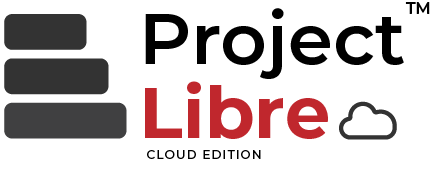
ProjectLibre is a free project management software that offers simple project management tools such as task lists, Gantt charts, project dashboards and resource management spreadsheets. Some of its key features include work breakdown structure (WBS) charts, resource histograms and network diagrams. It’s a downloadable open-source software that works on Windows, Mac and Linux computers, and it’s available in over 20 languages. One of its key advantages is that it can be used to view and edit Microsoft Project files without a Microsoft Project license.
Related: What Is ProjectLibre? Pros, Cons & Alternatives
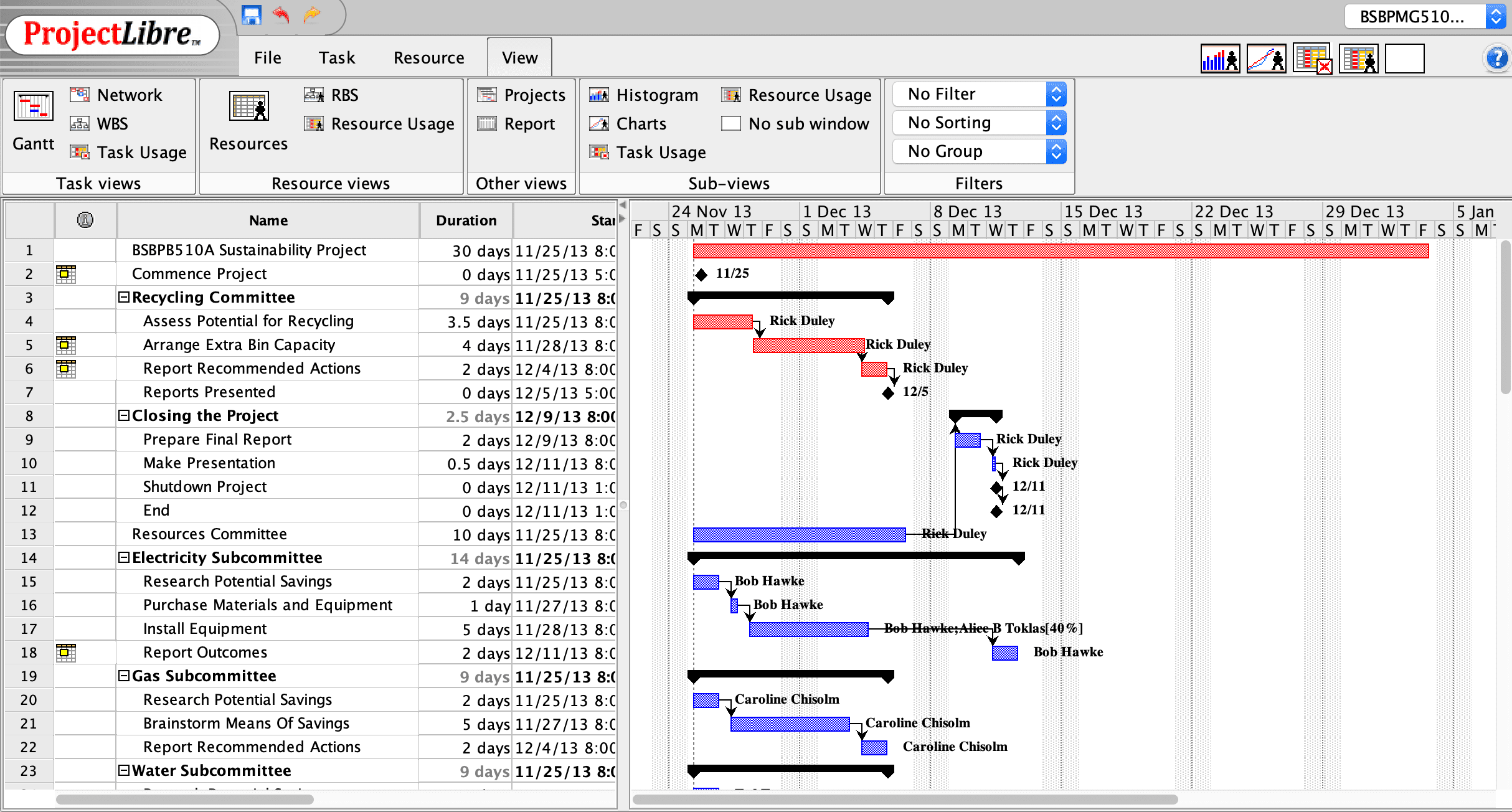
However, while ProjectLibre promotes itself as the best Microsoft Project alternative, it lacks many of the tools that Microsoft Project offers such as timesheets, kanban boards or project management reports. On top of that, its project management features are limited and its user interface is outdated compared to the vast majority of Microsoft Project alternatives.
Verdict: Best Open-source Microsoft Project Alternative
ProjectLibre & Key Features
- Globally accessible tool with support for over 20 languages, making it ideal for international teams and organizations operating across multiple regions. Its localization capabilities help teams work comfortably in their native language, improving collaboration and usability in diverse environments
- Unlike Microsoft Project, which is Windows-centric, ProjectLibre works seamlessly on macOS, Windows and Linux. This cross-platform compatibility makes it a strong option for teams using mixed operating systems, ensuring everyone can access and manage project files without software conflicts
- Offers a robust free plan with no licensing fees, making it a cost-effective alternative to Microsoft Project. It’s particularly well-suited for nonprofits, small businesses, freelancers and educational institutions that need advanced scheduling capabilities without the financial commitment
- Supports opening and editing Microsoft Project files (.MPP), allowing users to collaborate with teams still using Microsoft Project or migrate from it without losing project data. This compatibility provides an easy transition path and bridges the gap between proprietary and open-source project management environments
ProjectLibre Cons & Limitations
- Interface feels dated and unintuitive, especially when compared to modern project management tools. Its design and layout resemble older versions of Microsoft Project, which can lead to a steeper learning curve and user frustration—particularly for teams accustomed to sleek, modern UIs with responsive design and easy navigation
- Lacks many advanced features found in more robust tools. There’s no support for agile project management, real-time dashboards, kanban boards, time tracking or collaboration features like chat and file sharing. This makes it insufficient for managing complex or fast-moving projects across teams
- Resource planning capabilities are confined to basic spreadsheet-style views that lack depth and flexibility. There’s minimal support for workload balancing, availability forecasting or dynamic resource allocation—features that are increasingly standard in modern project management platforms
- As a desktop-based tool, ProjectLibre lacks cloud functionality, team collaboration and real-time syncing. Project files must be saved and shared manually, which can create version control issues, limit accessibility and slow down collaboration—especially in remote or distributed teams
- There is no mobile version of ProjectLibre, meaning users are tied to their desktop or laptop environments. For teams needing to monitor progress, adjust schedules or check in on tasks while in the field or traveling, this lack of mobile accessibility is a significant drawback
- Despite its simplicity in features, ProjectLibre can be unintuitive for new users—especially those without prior experience using Microsoft Project or other technical project management software. The limited help documentation and lack of user support further compound this issue, creating a barrier to adoption for less experienced users
ProjectLibre Pricing
- Free downloadable software
ProjectLibre Reviews
- G2 review: 4.2/5
- Capterra review: 4.4/5
- GetApp review: 4.4/5
Highlighted User Reviews
- “It’s open-source. It also provides Gantt charts, defining task dependencies, setting milestones and allocating resources.” Tisagh C – from G2
- “I was looking for a cheap or free alternative to MS Project to plan and follow my projects.” Nicolas B – from Capterra
- “This software is free! Also, it is very stable and has been around enough to have good help online and it is easy to import and export.” Max P – from GetApp
Which MS Project Alternative Is Right For You?
Microsoft Project is clunky, expensive and difficult-to-use project management software. Although it’s the default option for many, it doesn’t cater to every team’s needs.
Construction teams, for example, may feel limited by MS Project’s weak scheduling features, leaving them to find a Microsoft Project alternative with dynamic Gantt charts and resource allocation features. Marketing teams may look for an alternative with great integrations that go beyond the Microsoft umbrella, while students may seek a free or open-source Microsoft Project alternative that better fits their budget and workflow.
Related Microsoft Project Content
- Top Microsoft Project Management Software
- Best Project Management Software: Rankings, Reviews & Comparisons
- Best Project Management Software
- Best Microsoft Planner Alternatives
- Best Monday.com Alternatives
- Best Smartsheet Alternatives
- Best ClickUp Alternatives
- Best Wrike Alternatives
- Best Asana Alternatives
- 10 Mejores Alternativas a Microsoft Project (2025)
- 10 meilleures alternatives à Microsoft Project : options gratuites et payantes
- 10 beste Microsoft Project Alternativen: Kostenlose & kostenpflichtige Optionen
- 10 beste Microsoft Project Alternativen: Kostenlose & kostenpflichtige Optionen
ProjectManager is award-winning software that organizes tasks, teams and projects. It’s the best Microsoft alternative, with all the features and none of the frustration. You can use it to import and export MS Project files or better yet, abandon the expensive tool and subscribe to ours with multiple payment tiers. Try it free today.

